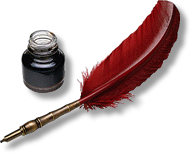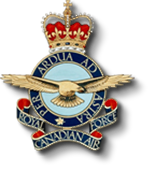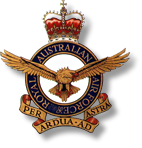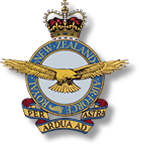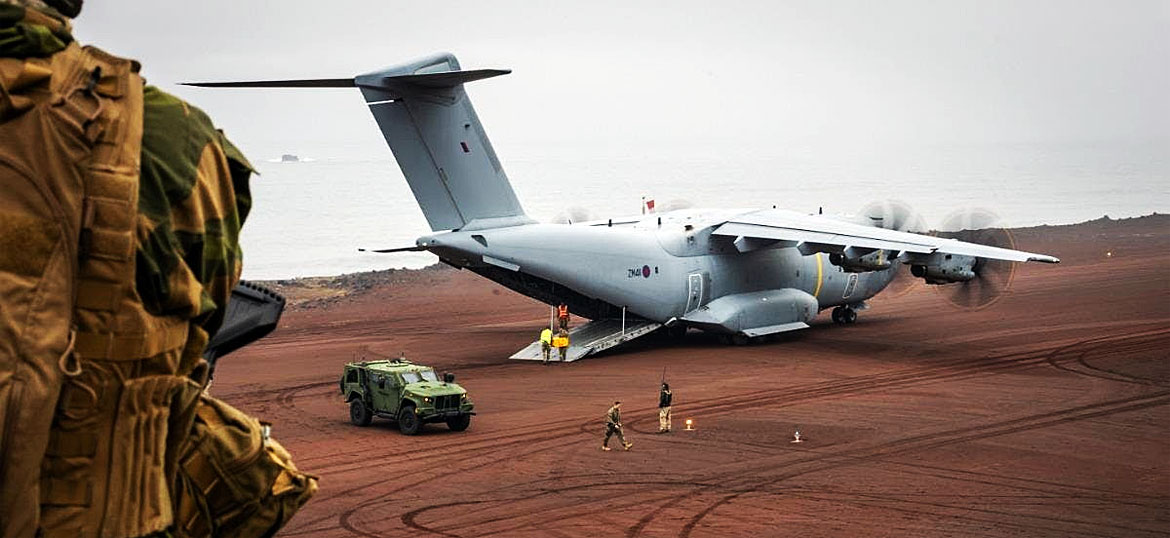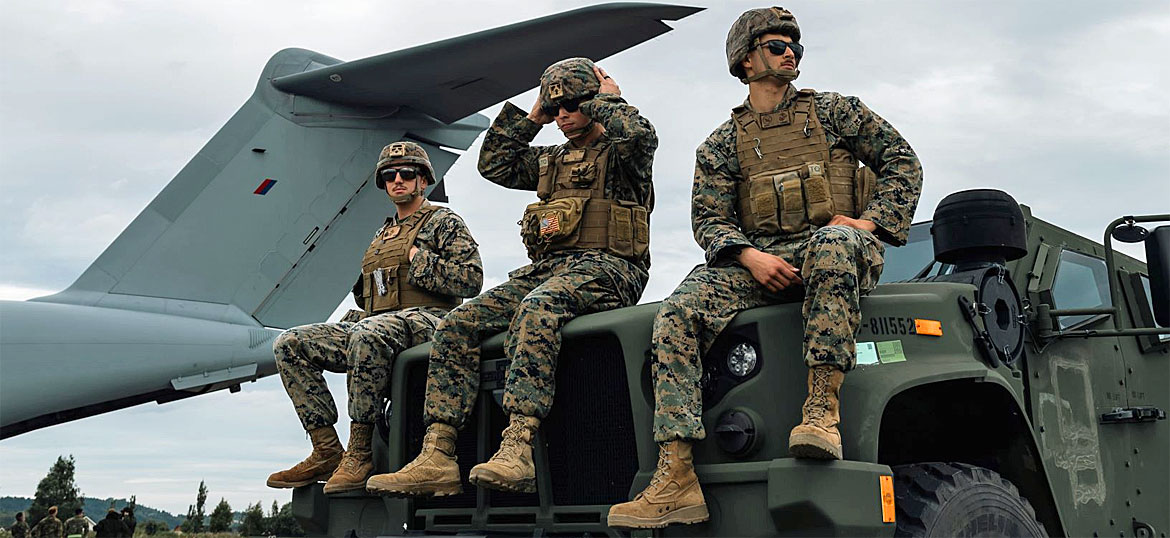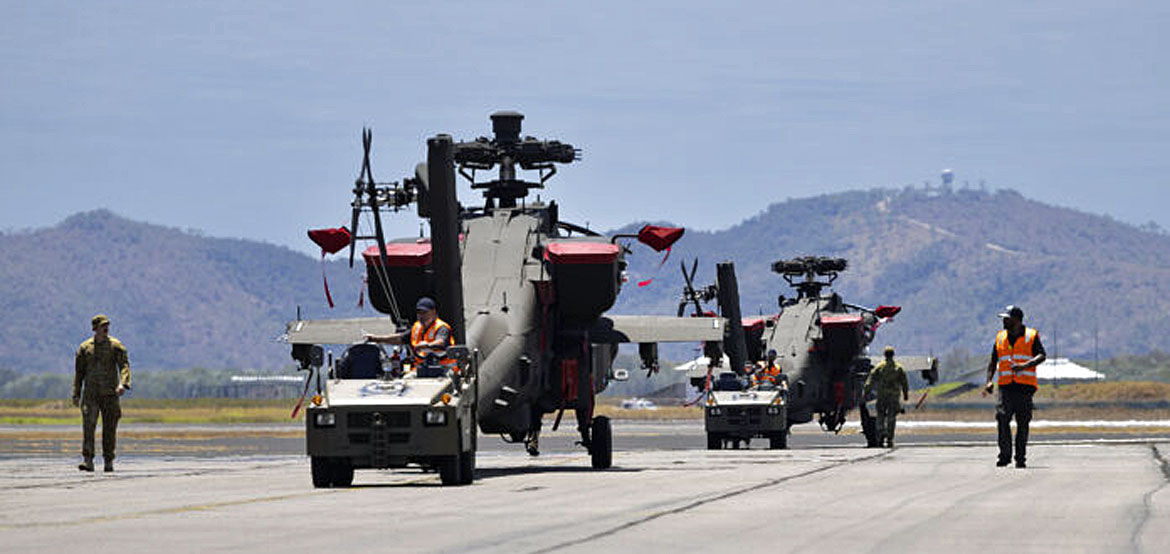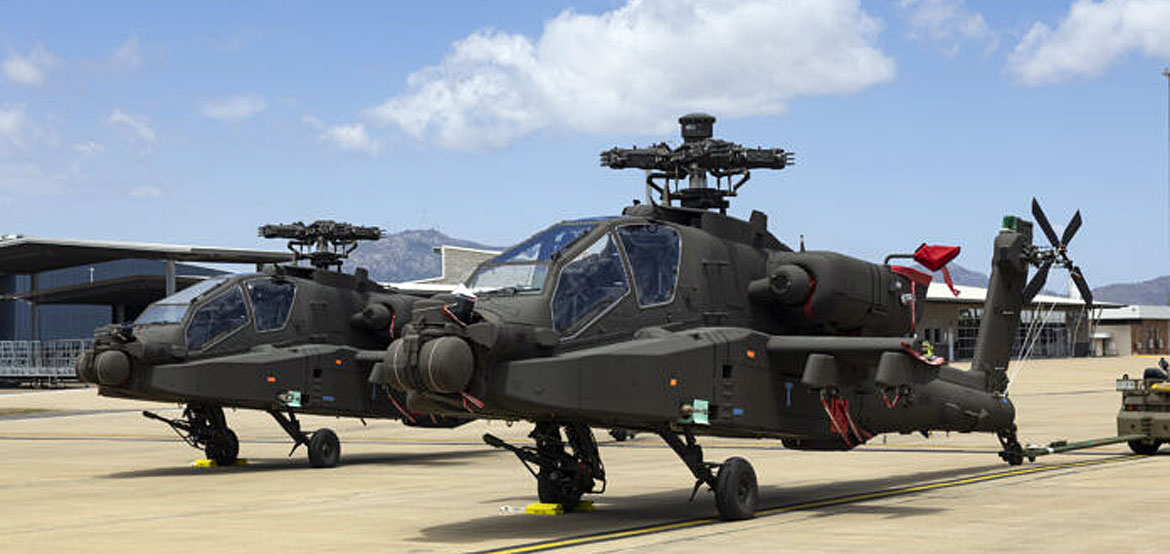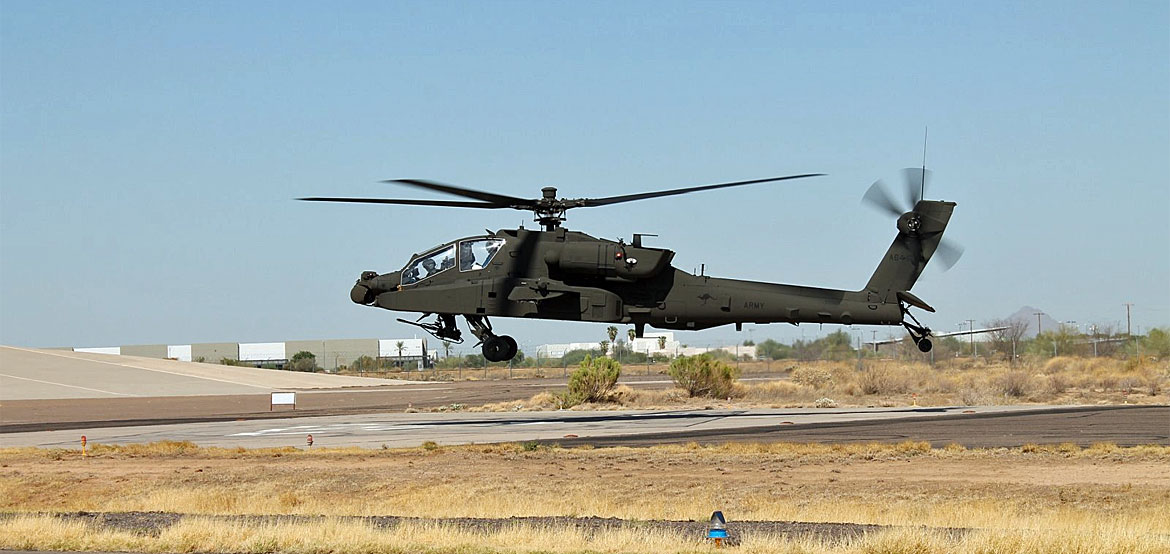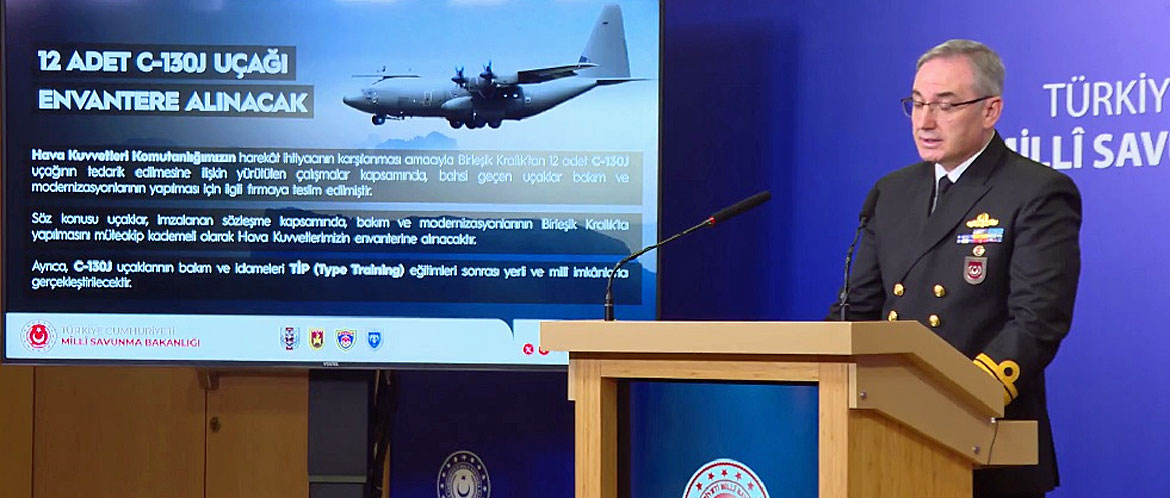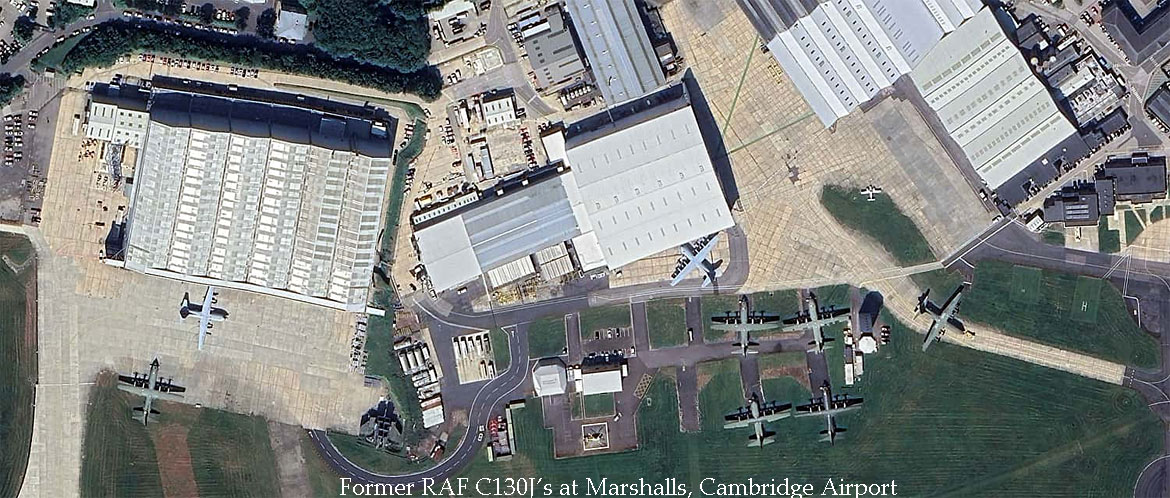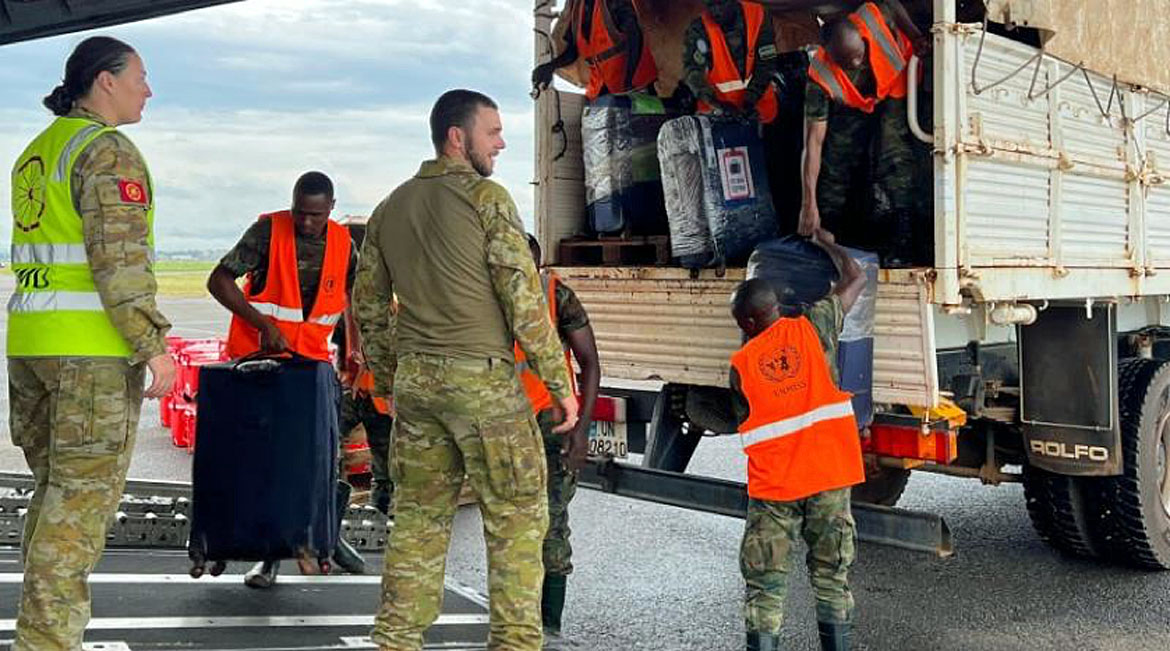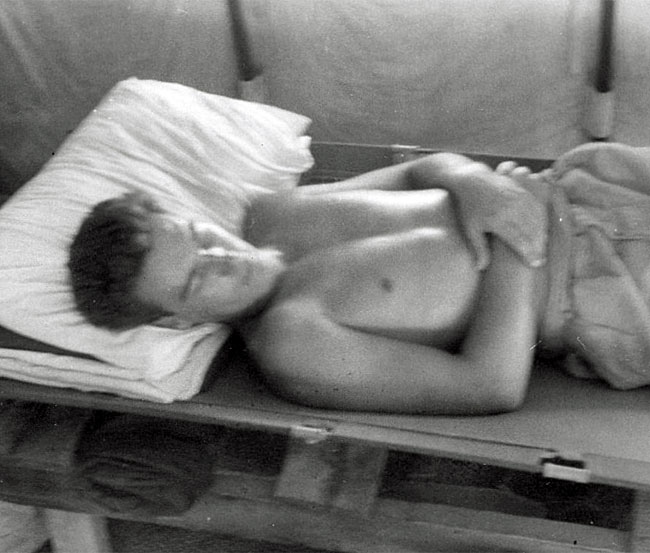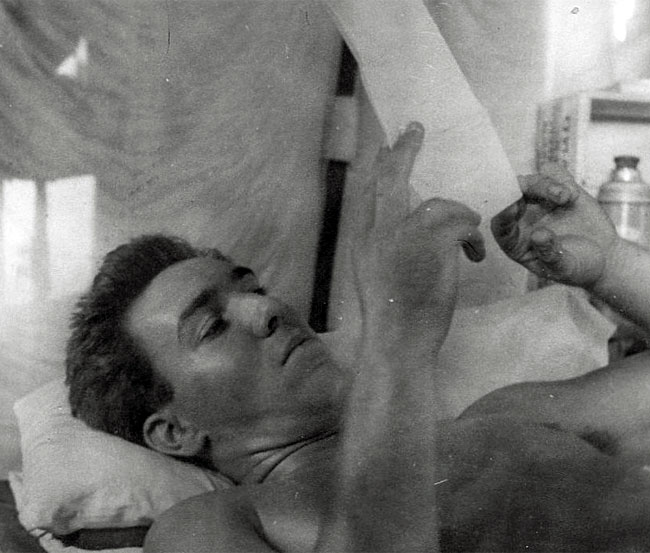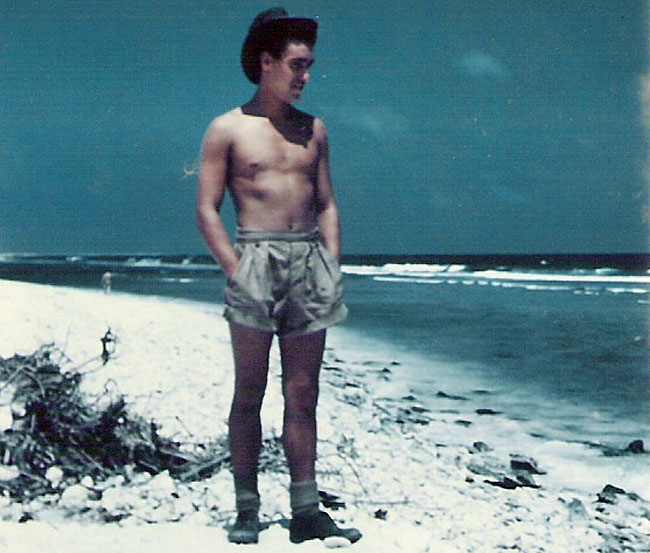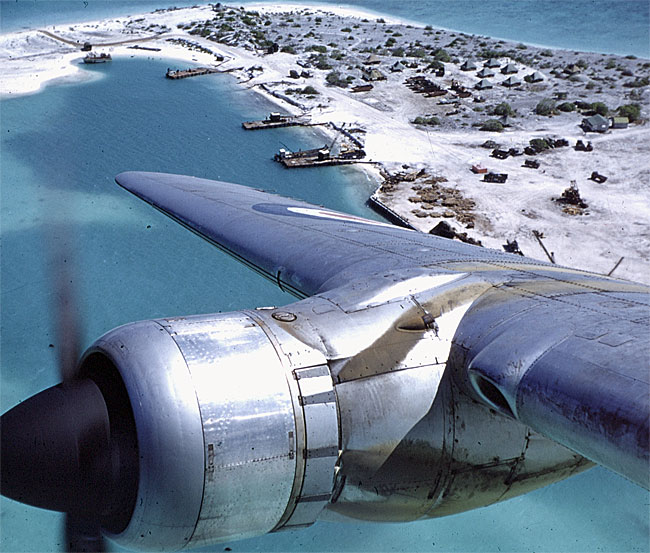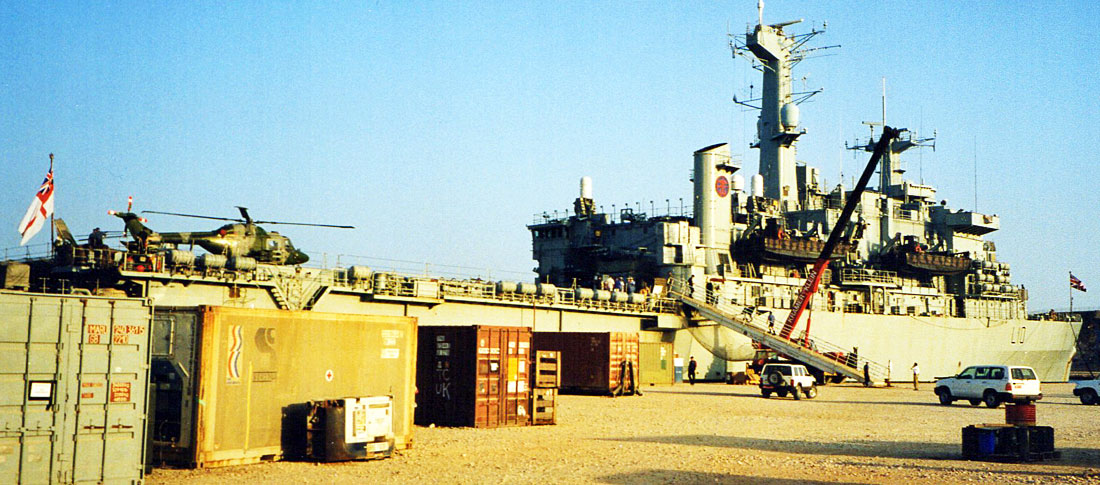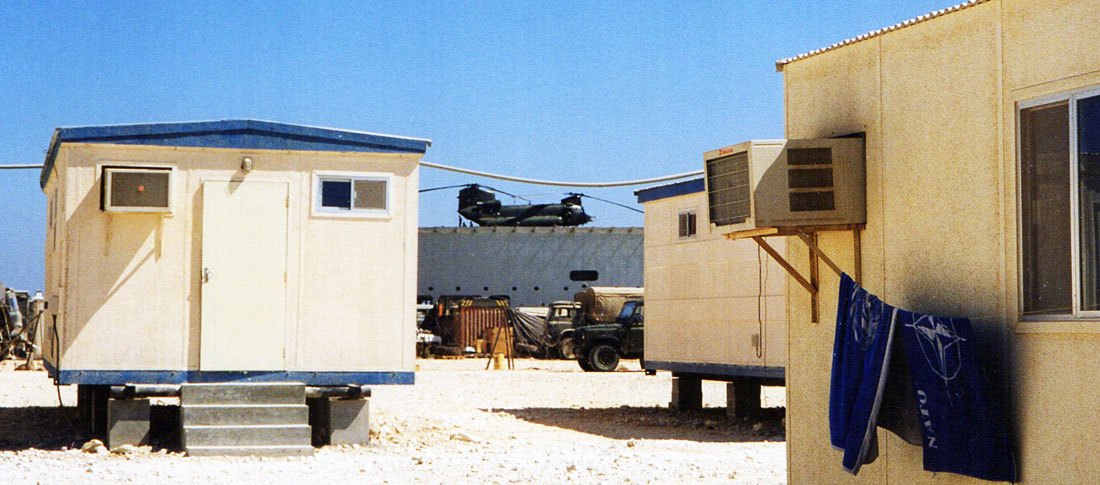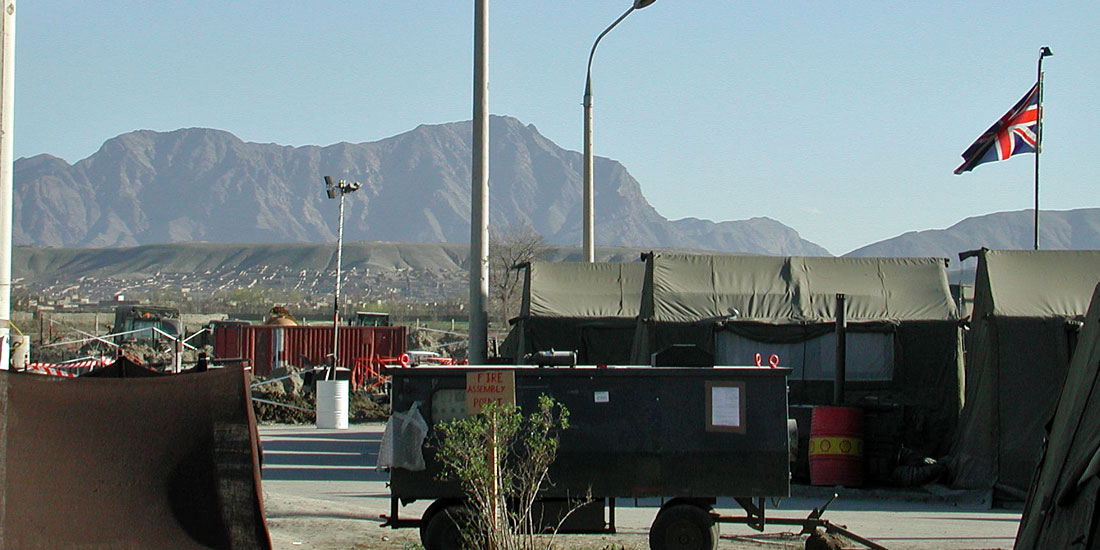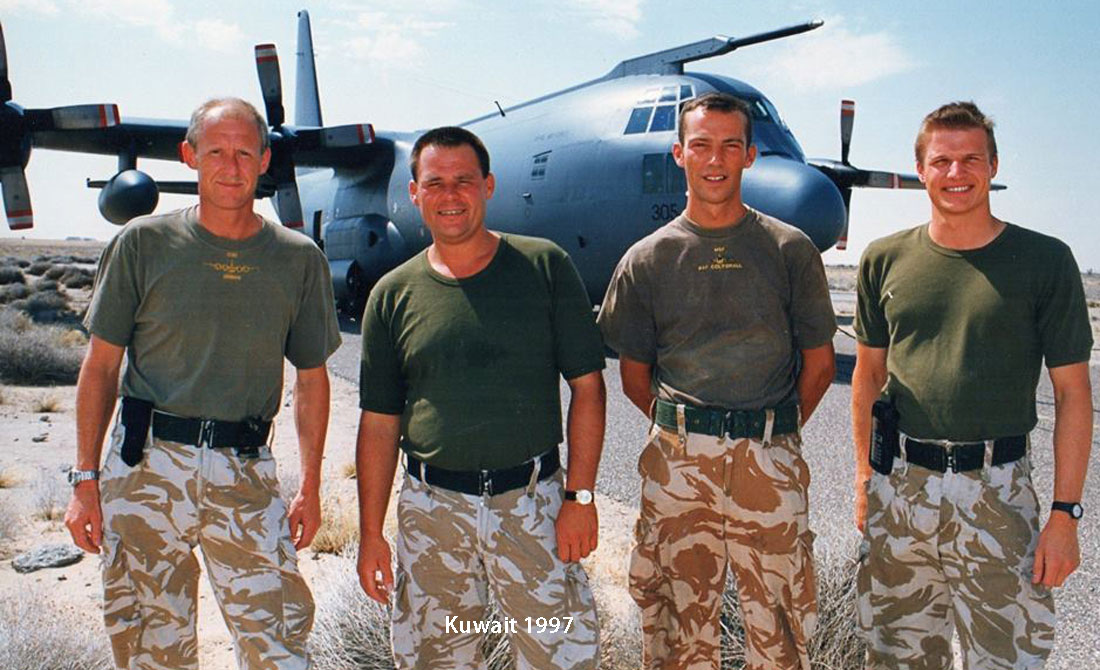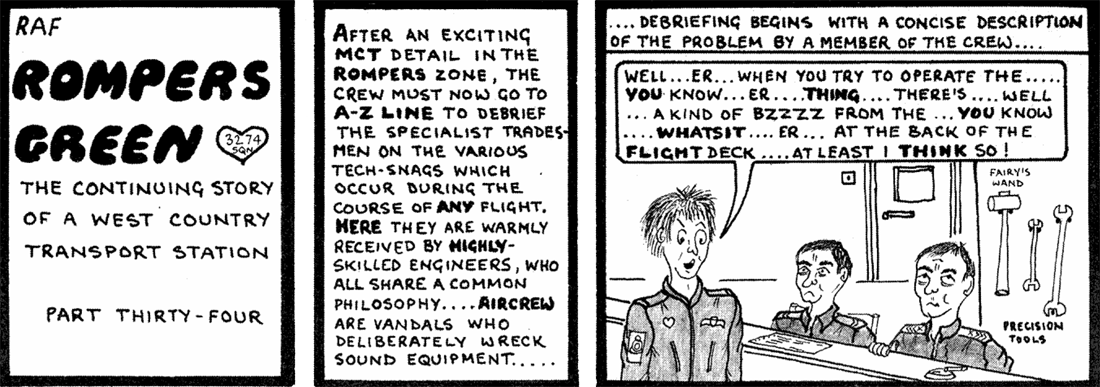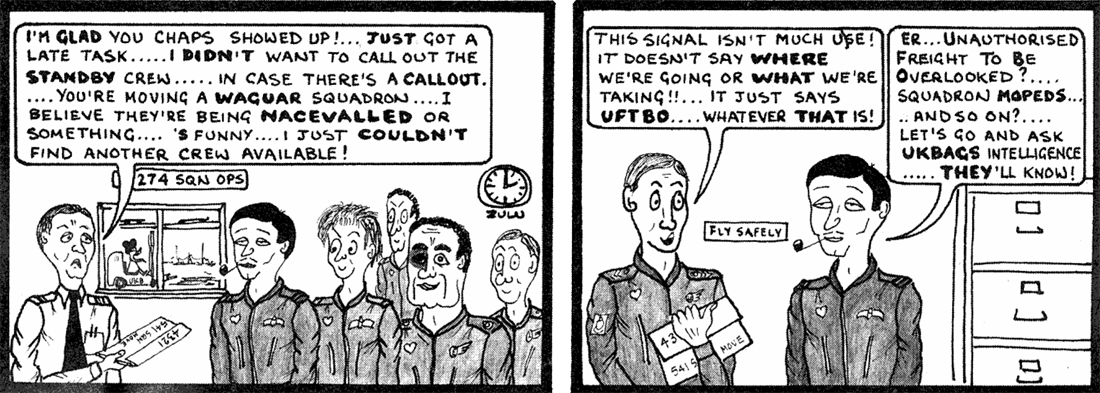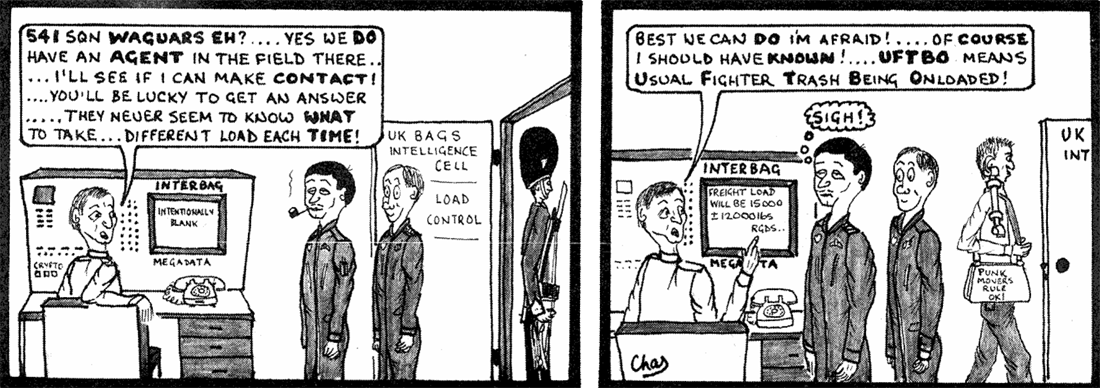






RAF A400M Achieves Historic Landing on Remote Arctic Island

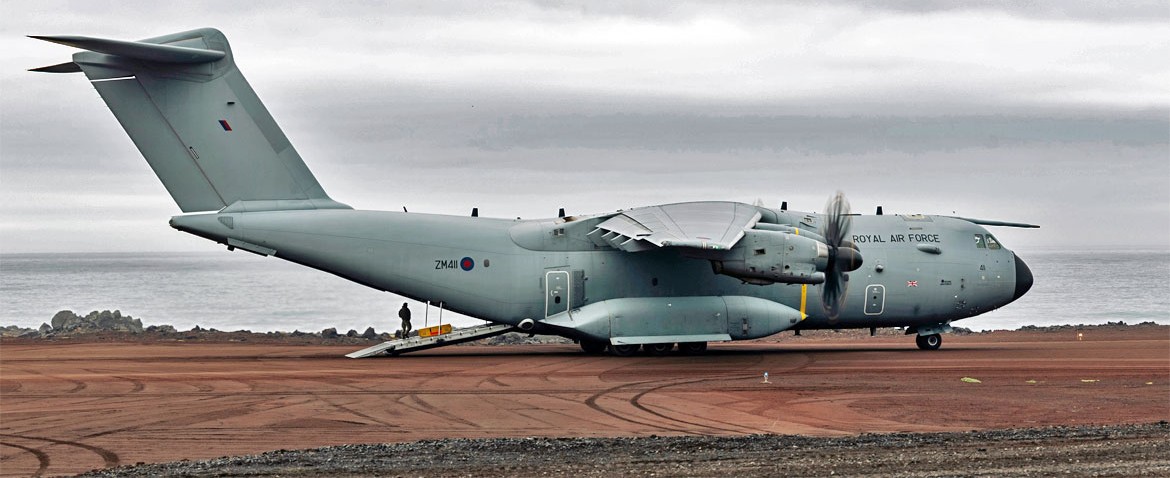
In a landmark operation, a UK Royal Air Force (RAF) A400M Atlas transport aircraft successfully landed on Jan Mayen, a remote volcanic island in the Norwegian Sea, marking the first-ever landing of its kind. The mission demonstrated the RAF’s ability to deliver critical equipment to austere and isolated locations, reinforcing NATO’s strategic presence in the High North.
The A400M transported a U.S. Marine Corps Joint Light Tactical Vehicle (JLTV) from pre-positioned locations in Norway, supporting a multinational deployment that included the Norwegian Armed Forces, UK Royal Marines, and U.S. Marines. The JLTV simulated the Navy/Marine Expeditionary Ship Interdiction System (NMESIS), with operations conducted from two locations on the island.
Jan Mayen, part of Norway’s sovereign territory, is strategically vital for NATO, serving as a key node for transatlantic supply routes and freedom of navigation in the Arctic. The RAF’s role in this mission highlights its capability to project air mobility into challenging environments, ensuring the Alliance’s readiness to operate in contested and extreme conditions.
The mission tested the RAF’s ability to operate in harsh Arctic conditions, where weather and terrain demand meticulous planning. With resupply difficult, the deployment required careful preparation, ensuring all essential equipment, rations, and supplies were included from the outset. Critically, it underscores the importance of air power in enabling multi-domain operations and maintaining readiness in the High North.
Vice Admiral Rune Andersen, Chief of the Norwegian Joint Headquarters said, “Operating jointly with Allies demonstrates both capability and commitment to defend Arctic islands, the High North, and surrounding waters if required. Our strength lies in our ability to integrate capabilities across domains and among NATO Allies. Regular Allied training and operations in Norway ensure readiness across all seasons and in times of crisis or conflict. This contributes to collective security and credible deterrence against future aggression. NATO remains a defensive alliance, but one always ready to respond if challenged."
The RAF’s participation in this deployment reflects its commitment to NATO’s collective security and its ability to adapt to the unique challenges of Arctic operations. By integrating seamlessly with Allied forces, the RAF continues to play a vital role in safeguarding freedom of navigation and ensuring credible deterrence in the region.
Air Marshal Allan Marshall, RAF's Air and Space Commander said, “Landing the A400M on Jan Mayen demonstrates the RAF’s agility and reach, delivering critical capability to a remote location in support of NATO’s collective defence and deterrence efforts. This operation underscores the importance of air power within multi-domain operations and deterrence in the High North.”
raf.mod.uk
The A400M transported a U.S. Marine Corps Joint Light Tactical Vehicle (JLTV) from pre-positioned locations in Norway, supporting a multinational deployment that included the Norwegian Armed Forces, UK Royal Marines, and U.S. Marines. The JLTV simulated the Navy/Marine Expeditionary Ship Interdiction System (NMESIS), with operations conducted from two locations on the island.
Jan Mayen, part of Norway’s sovereign territory, is strategically vital for NATO, serving as a key node for transatlantic supply routes and freedom of navigation in the Arctic. The RAF’s role in this mission highlights its capability to project air mobility into challenging environments, ensuring the Alliance’s readiness to operate in contested and extreme conditions.
The mission tested the RAF’s ability to operate in harsh Arctic conditions, where weather and terrain demand meticulous planning. With resupply difficult, the deployment required careful preparation, ensuring all essential equipment, rations, and supplies were included from the outset. Critically, it underscores the importance of air power in enabling multi-domain operations and maintaining readiness in the High North.
Vice Admiral Rune Andersen, Chief of the Norwegian Joint Headquarters said, “Operating jointly with Allies demonstrates both capability and commitment to defend Arctic islands, the High North, and surrounding waters if required. Our strength lies in our ability to integrate capabilities across domains and among NATO Allies. Regular Allied training and operations in Norway ensure readiness across all seasons and in times of crisis or conflict. This contributes to collective security and credible deterrence against future aggression. NATO remains a defensive alliance, but one always ready to respond if challenged."
The RAF’s participation in this deployment reflects its commitment to NATO’s collective security and its ability to adapt to the unique challenges of Arctic operations. By integrating seamlessly with Allied forces, the RAF continues to play a vital role in safeguarding freedom of navigation and ensuring credible deterrence in the region.
Air Marshal Allan Marshall, RAF's Air and Space Commander said, “Landing the A400M on Jan Mayen demonstrates the RAF’s agility and reach, delivering critical capability to a remote location in support of NATO’s collective defence and deterrence efforts. This operation underscores the importance of air power within multi-domain operations and deterrence in the High North.”
raf.mod.uk

From: Stephen Davey, Tadcaster, North Yorks
Subject: Under Canvas
Hi Tony,
This subject "Under Canvas" is the reason why I never took to camping! In May 1977, whilst I was stationed at RAF Wittering, 1 Squadron were tasked to RAF Leeming for a week-long detachment as a precursor to a detachment in Norway later that year.
As I was movements qualified, it was decided that I should accompany the Mobility Flight personnel (please note I didn't volunteer for this!).
From the moment we arrived it never stopped raining and as we were billeted in 6-man tents the whole situation became miserable. It was finally crowned one morning when I woke up and discovered the tent floor was covered in 4 inches of water!
On the day we packed up to return to Wittering the sun shone!
Regards
Steve Davey
Subject: Under Canvas
Hi Tony,
This subject "Under Canvas" is the reason why I never took to camping! In May 1977, whilst I was stationed at RAF Wittering, 1 Squadron were tasked to RAF Leeming for a week-long detachment as a precursor to a detachment in Norway later that year.
As I was movements qualified, it was decided that I should accompany the Mobility Flight personnel (please note I didn't volunteer for this!).
From the moment we arrived it never stopped raining and as we were billeted in 6-man tents the whole situation became miserable. It was finally crowned one morning when I woke up and discovered the tent floor was covered in 4 inches of water!
On the day we packed up to return to Wittering the sun shone!
Regards
Steve Davey



First AH-64E Apache's delivered to Australia
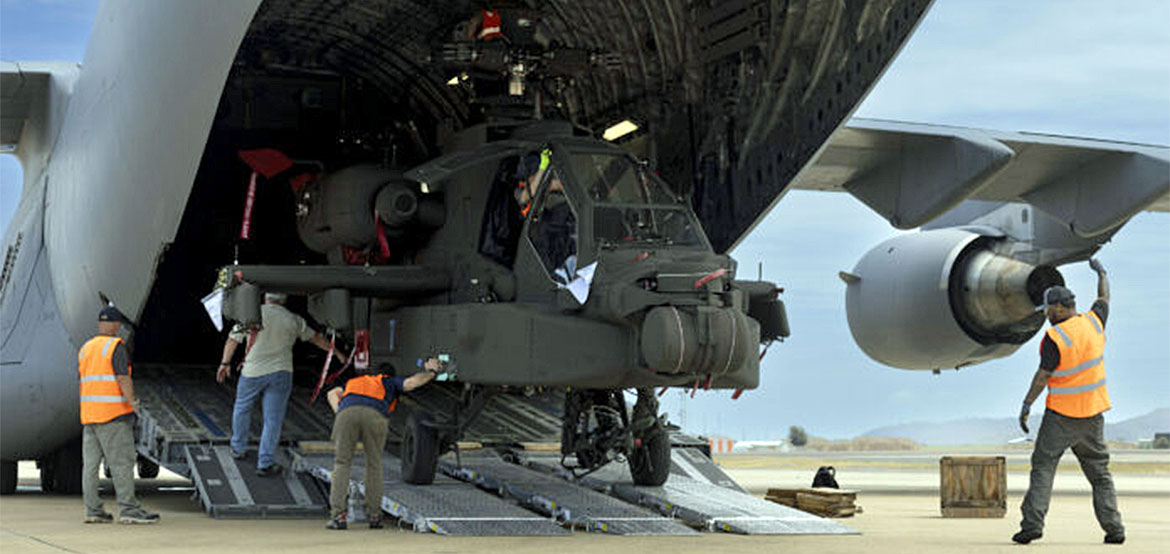
Australia’s first two Boeing AH-64E Apache helicopters have arrived at RAAF Base Townsville, ushering in a new era of attack helicopter capability for Australia, backed by an Australian workforce and supply chain.
“The delivery of the first two Australian Apache's underscores the strength of Boeing’s enduring partnership with Australia,” said Christina Upah, vice president of Boeing Attack Helicopter Programs. “Working side-by-side with the Australian Army, Capability Acquisition and Sustainment Group and local industry, we are delivering the world’s most advanced attack helicopter capability purpose-built to ensure battlefield dominance, bolster interoperability with allied nations, and evolve with the latest technologies for decades to come.”
The next two Apache's of the 29 ordered are on track for delivery before the end of the year. All 29 aircraft are expected to be delivered by 2029.
asiapacificdefencereporter.com
“The delivery of the first two Australian Apache's underscores the strength of Boeing’s enduring partnership with Australia,” said Christina Upah, vice president of Boeing Attack Helicopter Programs. “Working side-by-side with the Australian Army, Capability Acquisition and Sustainment Group and local industry, we are delivering the world’s most advanced attack helicopter capability purpose-built to ensure battlefield dominance, bolster interoperability with allied nations, and evolve with the latest technologies for decades to come.”
The next two Apache's of the 29 ordered are on track for delivery before the end of the year. All 29 aircraft are expected to be delivered by 2029.
asiapacificdefencereporter.com

From: Richard Gunn, York, Yorkshire
Subject: Under Canvas
Hello Tony,
Our holiday cottages were excellent for mosquitos and sandflies. The first trips when we were on our own initially self catering, then mess with a 5004 AC cook, the last one I did we were billeted with the army - it was dreadful!
The photos were taken at Thumier, about 50 miles north of Aden in Yemen - circa 1964-65
Regards
Richard
Subject: Under Canvas
Hello Tony,
Our holiday cottages were excellent for mosquitos and sandflies. The first trips when we were on our own initially self catering, then mess with a 5004 AC cook, the last one I did we were billeted with the army - it was dreadful!
The photos were taken at Thumier, about 50 miles north of Aden in Yemen - circa 1964-65
Regards
Richard


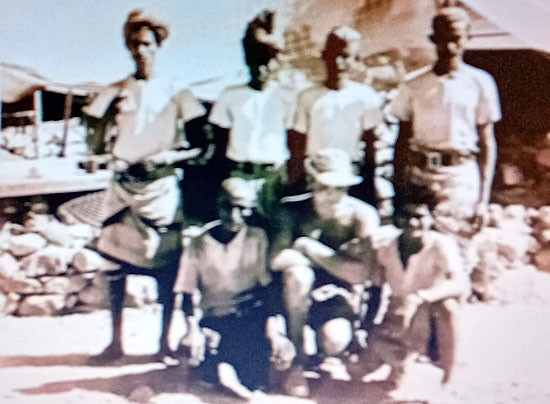
Routine Adventure in Aden (1965)
Watch on YouTube - https://www.youtube.com/watch?v=Ks-ymRuo_Z8

UK begins pre-delivery overhaul for TurAF’s 12 C-130Js

Türkiye’s Ministry of National Defence (Turkish MoD) confirmed that the aircraft had been handed over to a British firm for maintenance and modernization ahead of delivery. “Within the scope of the contract signed for the procurement of 12 C-130J aircraft from the United Kingdom to meet the operational needs of our Air Force Command, the aircraft have been delivered to the relevant company for maintenance and modernization,” the Ministry spokesperson Admiral Aktürk said. “Following these works in the UK, they will be gradually incorporated into our Air Force inventory. Maintenance and sustainment will subsequently be performed domestically after Type Training (TİP).”
The Royal Air Force initially procured ten C-130J and fifteen C-130J-30 aircraft in the mid-1990s, with the first extended-fuselage variant entering service in 1999. Following the induction of the A400M Atlas, the UK decided to phase out its Hercules fleet, and the Defence Equipment Sales Authority (DESA) was tasked with managing their sale.
To increase resale value and airworthiness, DESA initiated pre-sale maintenance that includes the replacement of key structural components such as the Centre Wing Box (CWB).
With the retirement of its C-160 Transalls, the Turkish Air Force has relied heavily on its A400M, CN-235, and C-130 aircraft. The arrival of the extended-fuselage C-130J-30s is expected to enhance payload flexibility and reduce the operational burden on A400Ms for medium-lift missions.
turdef.com
The Royal Air Force initially procured ten C-130J and fifteen C-130J-30 aircraft in the mid-1990s, with the first extended-fuselage variant entering service in 1999. Following the induction of the A400M Atlas, the UK decided to phase out its Hercules fleet, and the Defence Equipment Sales Authority (DESA) was tasked with managing their sale.
To increase resale value and airworthiness, DESA initiated pre-sale maintenance that includes the replacement of key structural components such as the Centre Wing Box (CWB).
With the retirement of its C-160 Transalls, the Turkish Air Force has relied heavily on its A400M, CN-235, and C-130 aircraft. The arrival of the extended-fuselage C-130J-30s is expected to enhance payload flexibility and reduce the operational burden on A400Ms for medium-lift missions.
turdef.com

From: Dougie Russell, Carlisle
Subject: Under Canvas
Hi Tony,
Can’t help with an "under canvas" tale , but as a newly-promoted JNCO i/c UKMAMS stores in 1989, it was my job to ensure we were fully equipped for immediate deployment to any worldwide area (as per AP1827).
When I discovered that we only had enough equipment to deploy 2 of the 11 teams, I set about correcting this issue and sourced 11 more 12' x 12' tents and associated equipment and got them loaded into trailers ready for immediate deployment. It took approximately 7 months before I could relax knowing I’d done my job.
July 1990, got a phone call from WO i/c UKMAMS; how long to get 5 teams' worth of kit ready? My answer, about 10 minutes, the teams just need gas and water and are ready to go... the Gulf War deployment.
So, although I never camped out whilst on UKMAMS, I made sure the kit was there for the cream boys on mobile.
Regards,
Dougie
p.s. I served my time under canvas 1985-1988 at JHSU(G) Germany in all kinds of weather.
Subject: Under Canvas
Hi Tony,
Can’t help with an "under canvas" tale , but as a newly-promoted JNCO i/c UKMAMS stores in 1989, it was my job to ensure we were fully equipped for immediate deployment to any worldwide area (as per AP1827).
When I discovered that we only had enough equipment to deploy 2 of the 11 teams, I set about correcting this issue and sourced 11 more 12' x 12' tents and associated equipment and got them loaded into trailers ready for immediate deployment. It took approximately 7 months before I could relax knowing I’d done my job.
July 1990, got a phone call from WO i/c UKMAMS; how long to get 5 teams' worth of kit ready? My answer, about 10 minutes, the teams just need gas and water and are ready to go... the Gulf War deployment.
So, although I never camped out whilst on UKMAMS, I made sure the kit was there for the cream boys on mobile.
Regards,
Dougie
p.s. I served my time under canvas 1985-1988 at JHSU(G) Germany in all kinds of weather.


From: Barry Tappenden, Shortstown, Beds
Subject: Under Canvas
Good afternoon Tony,
Operation Crown - Loeng Nok Tha Airfield.
It was never a problem being under canvas but one incident did highlight the problems. The team was to stay at Loeng Nok Tha airfield for a few days to assist in the final preparations for the opening.
Sleeping on camp-beds seemed a bit of a luxury and a saviour, especially when it rained and the flood of water cascaded through the tent ensuring our kit would be turned into miniature boats!
Failing that it was a very successful task, and we were made aware of the dangers that lurked by the daily routine orders issued by the RAMC!
Barry
Subject: Under Canvas
Good afternoon Tony,
Operation Crown - Loeng Nok Tha Airfield.
It was never a problem being under canvas but one incident did highlight the problems. The team was to stay at Loeng Nok Tha airfield for a few days to assist in the final preparations for the opening.
Sleeping on camp-beds seemed a bit of a luxury and a saviour, especially when it rained and the flood of water cascaded through the tent ensuring our kit would be turned into miniature boats!
Failing that it was a very successful task, and we were made aware of the dangers that lurked by the daily routine orders issued by the RAMC!
Barry

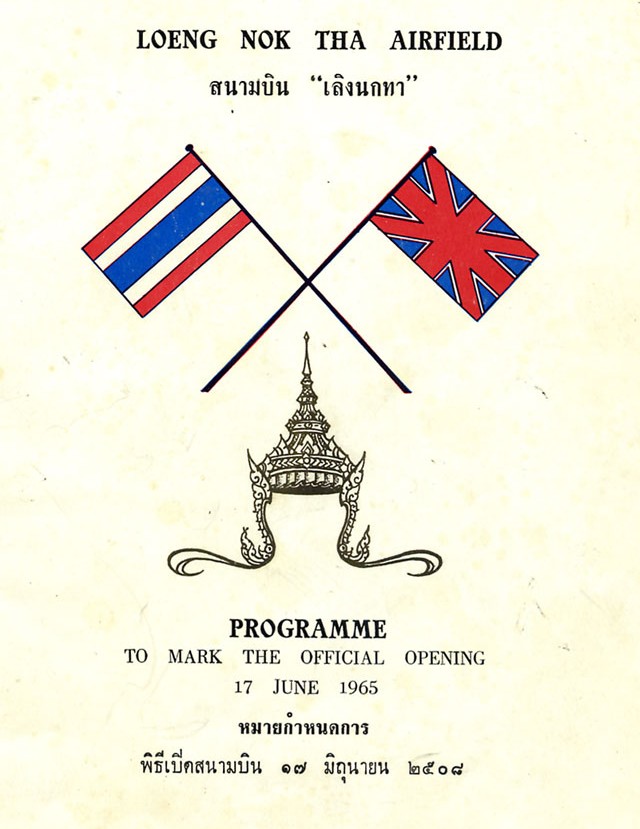
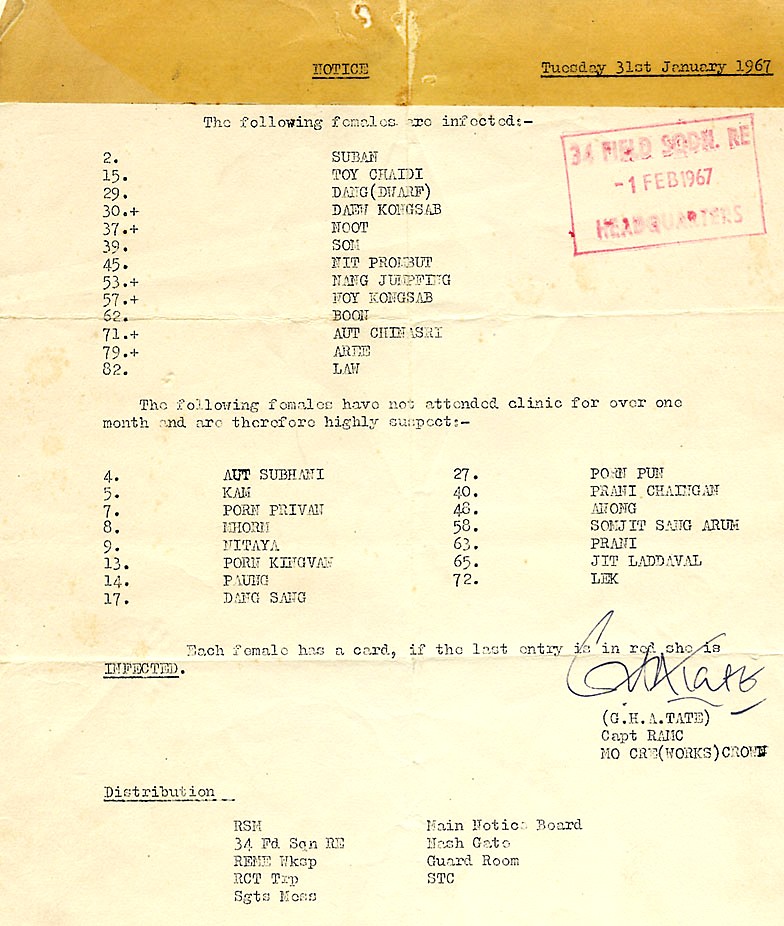

RAF personnel win fight against MoD for vegan uniforms
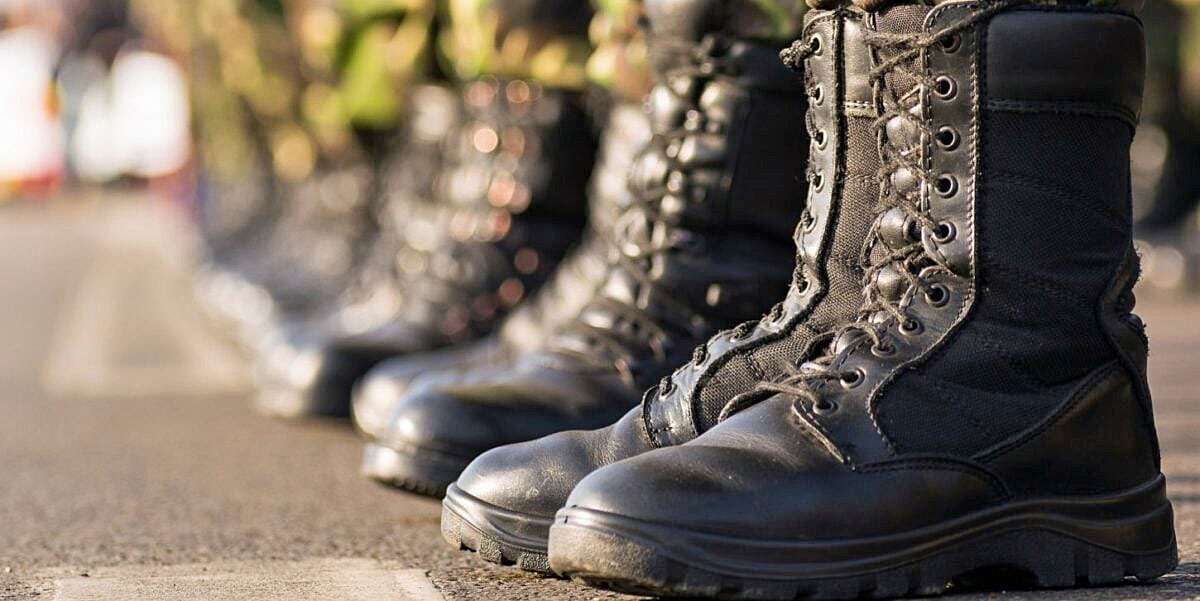
After a long-running campaign by the UK’s Ministry of Defence (MOD) Vegan and Vegetarian Network, service personnel who identify as ethical vegans must be supplied with appropriate uniforms that fit their lifestyle, such as leather-free boots and wool-free berets.
According to The Telegraph, internal documents now specify that vegan-friendly uniforms must now be made available to the armed forces. If vegans alert their chain of command that they “would like to wear clothes or accessories that do not come from animals” because of their “genuinely held beliefs,” a six-step procurement process is begun by superior officers.
All vegan clothing, footwear, and accessories must meet the RAF’s safety regulations before being presented to the station warrant officer, who will give the final sign-off.
“RAF personnel have the option to replace items of clothing/uniform in line with their own morals and values,” a spokesperson told The Telegraph. “Personnel must identify which items they would like to use instead of issued items, which will be considered by the chain of command and health and safety advisers to ensure suitability,” they added. “These items are subject to budgetary limits and senior approval.”
The Telegraph
(Ed: Heck - don't blame me, I'm just the messenger - what a bunch of dainty cup cakes nowadays!)
According to The Telegraph, internal documents now specify that vegan-friendly uniforms must now be made available to the armed forces. If vegans alert their chain of command that they “would like to wear clothes or accessories that do not come from animals” because of their “genuinely held beliefs,” a six-step procurement process is begun by superior officers.
All vegan clothing, footwear, and accessories must meet the RAF’s safety regulations before being presented to the station warrant officer, who will give the final sign-off.
“RAF personnel have the option to replace items of clothing/uniform in line with their own morals and values,” a spokesperson told The Telegraph. “Personnel must identify which items they would like to use instead of issued items, which will be considered by the chain of command and health and safety advisers to ensure suitability,” they added. “These items are subject to budgetary limits and senior approval.”
The Telegraph
(Ed: Heck - don't blame me, I'm just the messenger - what a bunch of dainty cup cakes nowadays!)

From: Tony Gale, Gatineau, QC
Subject: Under Canvas
Hello All,
(The following is an extract from the book "UKMAMS, Moving in Mysterious Ways" by Jerry Porter)
Complete Unity - The UKMAMS teams were deployed in large numbers in early June 1970 to Malaysia to take part in a five-nation exercise somewhat optimistically named Bersatu Padu. As nearly everyone will be aware "Bersatu Padu" is Malay for "complete unity."
Despite the regular comforts that MAMS had acquired, the work was still hard and quite often dirty. Sadly, the laundry service in the jungle proved inadequate for the teams needs and, once again, a local solution was found to the problem.
The cooks were approached for the loan of a large cooking pot which, owing to the shortage of food, was unlikely to be employed in its primary role. Team members Taff Eynon, Tony Gale and Jerry Freezer built a large wood fire and erected a cauldron stand above the flames. Washing was boiled up in the pot until vaguely clean and then hung out on a makeshift washing line outside the MAMS tent. It was during such a laundry session one day that the planners sprung another "air attack".*
Subject: Under Canvas
Hello All,
(The following is an extract from the book "UKMAMS, Moving in Mysterious Ways" by Jerry Porter)
Complete Unity - The UKMAMS teams were deployed in large numbers in early June 1970 to Malaysia to take part in a five-nation exercise somewhat optimistically named Bersatu Padu. As nearly everyone will be aware "Bersatu Padu" is Malay for "complete unity."
Despite the regular comforts that MAMS had acquired, the work was still hard and quite often dirty. Sadly, the laundry service in the jungle proved inadequate for the teams needs and, once again, a local solution was found to the problem.
The cooks were approached for the loan of a large cooking pot which, owing to the shortage of food, was unlikely to be employed in its primary role. Team members Taff Eynon, Tony Gale and Jerry Freezer built a large wood fire and erected a cauldron stand above the flames. Washing was boiled up in the pot until vaguely clean and then hung out on a makeshift washing line outside the MAMS tent. It was during such a laundry session one day that the planners sprung another "air attack".*

Tony Gale, Penerak, Malaysia, 1970
The plumes of black smoke rising from the MAMS fire to high above the airstrip stimulated the rumour that real bombs were being used, and that the movers had received a direct hit. Senior staff, unimpressed with this contribution of visual realism to the proceedings, came to make their feelings known to the occupants of the MAMS tent, and to check that some catastrophe had not befallen the camp. This proved to be a mistake as they were further pushed into an apoplectic fit by the sight of numerous undergarments, compromising the camouflage of the site, as they fluttered conspicuously in the breeze.
Happy days!
Tony
Happy days!
Tony

*To simulate air attacks, RAAF Dassault Mirage III jets flew low over the base "dropping bombs" into the encampment, whilst on the ground the umpires were setting off flash-bangs - it all seemed to be very realistic.
From: David Powell, Princes Risborough, Bucks
Subject: Under Canvas
Hi Tony
Thank you for the latest ‘we’ve been everywhere’ challenge. This time, the pitter patter of great big rain-drops on canvas. My contribution is a bit of a cheat. It that predates my first MAMS tour, but it was on forward strip air movements duties where I was 50% of the deployed air movements force, and an excuse to dig out one or two prints of RAF life under canvas. The other 50% of sir movements was a brilliant mobility Corporal. I am sorry but I have forgotten his name for the moment. Well, it was over 60 years ago! We also doubled as the equipment specialists on 3 days a week.
The photos were taken in May 1965 at RAF Gong Kedak just south the Malaysia/Thai border near Kota Bharu, Kalantan. This was at the period of Confrontation with Indonesia. I am not quite sure of our role but it was probably to thwart any ideas of the potential enemy taking a page out of a Japanese 1942 play-book. Altogether, during my tour at RAF Changi, I must have spent four months under canvas at GK and at forward strips at Kuantan and Penerak.
Subject: Under Canvas
Hi Tony
Thank you for the latest ‘we’ve been everywhere’ challenge. This time, the pitter patter of great big rain-drops on canvas. My contribution is a bit of a cheat. It that predates my first MAMS tour, but it was on forward strip air movements duties where I was 50% of the deployed air movements force, and an excuse to dig out one or two prints of RAF life under canvas. The other 50% of sir movements was a brilliant mobility Corporal. I am sorry but I have forgotten his name for the moment. Well, it was over 60 years ago! We also doubled as the equipment specialists on 3 days a week.
The photos were taken in May 1965 at RAF Gong Kedak just south the Malaysia/Thai border near Kota Bharu, Kalantan. This was at the period of Confrontation with Indonesia. I am not quite sure of our role but it was probably to thwart any ideas of the potential enemy taking a page out of a Japanese 1942 play-book. Altogether, during my tour at RAF Changi, I must have spent four months under canvas at GK and at forward strips at Kuantan and Penerak.

Rank (Pilot Officer) had its privileges if permanent staff. The first photo is my single-officer domestic accommodation, an 8’ x 8’ tent.
Keen observers will note the belt of my bush jacket for wearing when there were VIP flights. Never actually worn at GK, possibly because Headquarters FEAF thought we were closed and no RAF VIPs ever came to see us.
The wonderful doorstep view of the airfield is somewhat spoilt by the afternoon tropical rainstorm.
Not seen, is my daytime lodger, a friendly bat which spent the day hanging from my tent ridge pole before going out at night.
Keen observers will note the belt of my bush jacket for wearing when there were VIP flights. Never actually worn at GK, possibly because Headquarters FEAF thought we were closed and no RAF VIPs ever came to see us.
The wonderful doorstep view of the airfield is somewhat spoilt by the afternoon tropical rainstorm.
Not seen, is my daytime lodger, a friendly bat which spent the day hanging from my tent ridge pole before going out at night.
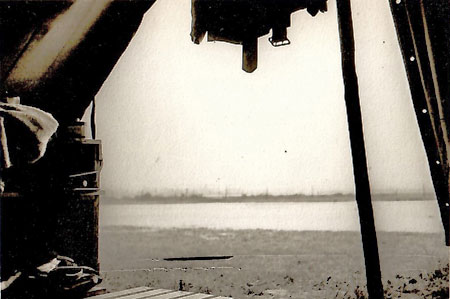
The second photo is our combined Supply Control/Load Control/Force Logistics office.
Note the total absence of a telephone or computer; which could be why our existence was largely overlooked by the RAF authorities.
Apart from my transistor radio, the only other piece of technology is my light meter, do you remember them for when taking photographs?
Next door was a similar tent which housed the combined technical, barrack and air cargo facilities. Note my officer’s SD Hat. Berets and Forage Caps were still some years away... and as for combat kit!
Note the total absence of a telephone or computer; which could be why our existence was largely overlooked by the RAF authorities.
Apart from my transistor radio, the only other piece of technology is my light meter, do you remember them for when taking photographs?
Next door was a similar tent which housed the combined technical, barrack and air cargo facilities. Note my officer’s SD Hat. Berets and Forage Caps were still some years away... and as for combat kit!

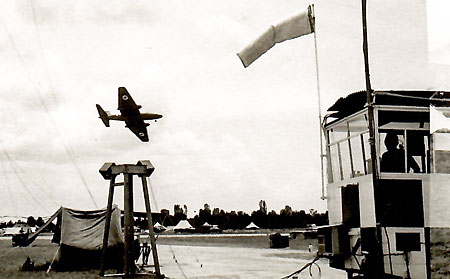
Finally, Tony, a photo of one of the RAAF Canberra PR/Bombers based with us while their hard standing at RAF Tengah was being refurbished.
Further tentage is in evidence as is our air portable air traffic tower. One weekend, I got a lift in the canvas jump seat of one of the Australian Canberra's when it popped back to RAF Tengah on a Friday for some bits, just in time for me to go to an excellent party at RAF Changi before hitching a ride back to GK on the weekly Monday RNZAF 41 Sqn Bristol Freighter. Happy Days!
Best wishes,
David Powell
F Team UKMAMS RAF Abingdon 1967-69
Further tentage is in evidence as is our air portable air traffic tower. One weekend, I got a lift in the canvas jump seat of one of the Australian Canberra's when it popped back to RAF Tengah on a Friday for some bits, just in time for me to go to an excellent party at RAF Changi before hitching a ride back to GK on the weekly Monday RNZAF 41 Sqn Bristol Freighter. Happy Days!
Best wishes,
David Powell
F Team UKMAMS RAF Abingdon 1967-69
RAF Brize Norton: Refurbishment Proposed for 'Ageing' Base
A proposed refurbishment and renovation of RAF Brize Norton will "futureproof the base for ongoing operational requirements", according to pre-application plans submitted to the council. A request for screening opinion on whether a redevelopment at the air force base in Carterton would require an environmental impact assessment has been submitted by the Defence Infrastructure Organisation, part of the Ministry of Defence, to West Oxfordshire District Council.
It comes after the Ministry of Defence suffered an attack on the airbase from pro-Palestine activists on June 20 when protesters broke into the base and vandalised two aircraft on the runway.
The new plans revealed in the request propose the like-for-like replacement of a vast amount of infra-structure at the "ageing" base. The proposal includes replacement and refurbishment of the runway, taxiways and hard surfaces to prevent further "deterioration". Also included is the replacement or provision aeronautical ground lighting, floodlighting and drainage, with the works to be delivered in four "packages".
Temporary construction compounds would be placed on the north and south sides of the base, at the station sports field and at 'Britannia Gate' in Station Road. Planned phased construction is due to start in March 2026 and would last 78 weeks, with demobilisation programmed from May to October 2027. The plans state there will be no overnight works and no construction traffic, which is expected to reach 200 vehicles per day at its peak, will be allowed to pass through the village of Brize Norton.
RAF Brize Norton is the largest airbase in the UK, employing more than 6,000 people, and is home to the UK’s refuelling fleet.
oxfordmail.co.uk
It comes after the Ministry of Defence suffered an attack on the airbase from pro-Palestine activists on June 20 when protesters broke into the base and vandalised two aircraft on the runway.
The new plans revealed in the request propose the like-for-like replacement of a vast amount of infra-structure at the "ageing" base. The proposal includes replacement and refurbishment of the runway, taxiways and hard surfaces to prevent further "deterioration". Also included is the replacement or provision aeronautical ground lighting, floodlighting and drainage, with the works to be delivered in four "packages".
Temporary construction compounds would be placed on the north and south sides of the base, at the station sports field and at 'Britannia Gate' in Station Road. Planned phased construction is due to start in March 2026 and would last 78 weeks, with demobilisation programmed from May to October 2027. The plans state there will be no overnight works and no construction traffic, which is expected to reach 200 vehicles per day at its peak, will be allowed to pass through the village of Brize Norton.
RAF Brize Norton is the largest airbase in the UK, employing more than 6,000 people, and is home to the UK’s refuelling fleet.
oxfordmail.co.uk
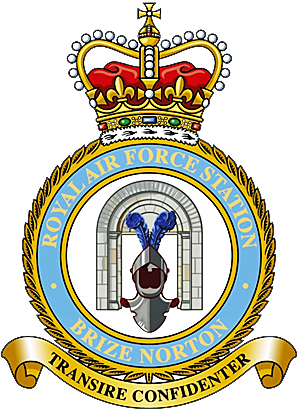

From: Paul “Taff” Kelly, Lyneham, Wilts
Subject: Under Canvas
Good afternoon, Tony,
Well, back in the day, UKMAMS deployed to Exercise Saif Sareea II in Oman. I have never seen so many tents, like a huge tent city.
The Americans had erected all of the facilities, roughing it under canvas, 45ºC every day and dropping down to -10ºc at night. Sleeping was a premium after 24-hour shifts, but luckily the American tents were air-conditioned, unlike ours; when they went to work during the day they let us utilize the spare tents. It was a hard detachment but great teams.
Taff
(Exercise Saif Sareea II was the second and largest Saif Sareea exercise which was held between 15 August and 26 October 2001. It was the largest single deployment of the British Armed Forces since the Gulf War in 1991 and trialed the newly-formed Joint Rapid Reaction Force. Over 22,500 personnel, 6,500 vehicles, 21 naval vessels, 49 fixed-wing aircraft and 44 helicopters were deployed; compared with the previous largest force of around 5,000 personnel. In addition over 11,000 Omani forces took part.)
Subject: Under Canvas
Good afternoon, Tony,
Well, back in the day, UKMAMS deployed to Exercise Saif Sareea II in Oman. I have never seen so many tents, like a huge tent city.
The Americans had erected all of the facilities, roughing it under canvas, 45ºC every day and dropping down to -10ºc at night. Sleeping was a premium after 24-hour shifts, but luckily the American tents were air-conditioned, unlike ours; when they went to work during the day they let us utilize the spare tents. It was a hard detachment but great teams.
Taff
(Exercise Saif Sareea II was the second and largest Saif Sareea exercise which was held between 15 August and 26 October 2001. It was the largest single deployment of the British Armed Forces since the Gulf War in 1991 and trialed the newly-formed Joint Rapid Reaction Force. Over 22,500 personnel, 6,500 vehicles, 21 naval vessels, 49 fixed-wing aircraft and 44 helicopters were deployed; compared with the previous largest force of around 5,000 personnel. In addition over 11,000 Omani forces took part.)


From: Andy Marshall, Carterton, Oxon
Subject: Under Canvas
Hi Tony,
The most memorable under canvas event I recall was the deployment to Denmark in September 1984 as part of the big NATO exercise. We were located behind the main Harrier Force camp in a dip. Needless to say it rained a lot and our site was soon a muddy mess, with our MK1 camp beds put on NATO pallets in order to keep a bit dryer.
Regards, Andy M
(In September 1984, a major NATO exercise, Bold Guard, took place in Denmark and Germany, involving Danish, German, American, British, and Dutch forces. This exercise was linked to a larger, multinational maritime exercise called "Northern Wedding" and included a significant land component with 47,000 troops, nearly 1,500 tracked vehicles, over 8,000 wheeled vehicles and about 200 helicopters.)
Subject: Under Canvas
Hi Tony,
The most memorable under canvas event I recall was the deployment to Denmark in September 1984 as part of the big NATO exercise. We were located behind the main Harrier Force camp in a dip. Needless to say it rained a lot and our site was soon a muddy mess, with our MK1 camp beds put on NATO pallets in order to keep a bit dryer.
Regards, Andy M
(In September 1984, a major NATO exercise, Bold Guard, took place in Denmark and Germany, involving Danish, German, American, British, and Dutch forces. This exercise was linked to a larger, multinational maritime exercise called "Northern Wedding" and included a significant land component with 47,000 troops, nearly 1,500 tracked vehicles, over 8,000 wheeled vehicles and about 200 helicopters.)
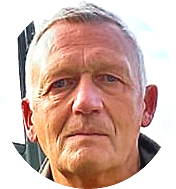
Aussies Proud of Peacekeeping Role

Every pallet loaded and every list checked gave Private Naomi Manton and Leading Aircraftman Blair Andrews pride in supporting the Vietnam People’s Army contingent to the United Nations Mission to South Sudan (UNMISS). It was their first peacekeeping mission as movement operators and involved coordinating cargo, logistics and supporting Vietnam’s medical contingent on deployment.
The ADF supported the deployment with strategic airlift assistance, carrying Vietnamese personnel and equipment on a C-17A Globemaster. The contingent consisted mainly of medical staff, deploying to operate a UN field hospital.
Private Manton was the movement’s liaison officer who coordinated passenger and transit arrangements, while Leading Aircraftman Andrews focused on cargo preparation and aircraft loading. Australian movement personnel also provided planning, cargo checks and coordination throughout transit, including stopovers in Seychelles, to ensure compliance with UN standards.
Leading Aircraftman Andrews said contributing to a peacekeeping operation was rewarding and reinforced why he joined Air Force. “I’ve got the opportunity to come over here and help the Vietnamese go over there and help other people,” he said. “I signed up not just for the opportunities, but to help other countries and people.”
Private Manton said her role involved coordinating passenger movements, booking accommodation during transit stops and ensuring the Vietnamese contingent arrived on time for flights. “It feels good to know that I am able to help in some way, even if I’m not necessarily on the ground,” Private Manton said. She said a challenge was the language barrier when recording details of the Vietnamese contingent’s movements. “The Vietnamese have been really helpful translating for me so we can get the job done,” she said. Private Manton served as a truck driver before transferring to movements, while Leading Aircraftman Andrews had other work experiences, but not peacekeeping.
On arrival in South Sudan, the ADF team was responsible for unloading cargo and ensuring the Vietnamese contingent disembarked safely. They also supervised the handling of equipment on the ground in South Sudan before the aircraft returned via Hanoi with an outgoing contingent of peacekeepers, then home to Darwin.
UNMISS was established to protect civilians and support stability after years of conflict in South Sudan. Australia’s deployment was part of broader support to regional partners contributing to UN peacekeeping operations.
contactairlandandsea.com
The ADF supported the deployment with strategic airlift assistance, carrying Vietnamese personnel and equipment on a C-17A Globemaster. The contingent consisted mainly of medical staff, deploying to operate a UN field hospital.
Private Manton was the movement’s liaison officer who coordinated passenger and transit arrangements, while Leading Aircraftman Andrews focused on cargo preparation and aircraft loading. Australian movement personnel also provided planning, cargo checks and coordination throughout transit, including stopovers in Seychelles, to ensure compliance with UN standards.
Leading Aircraftman Andrews said contributing to a peacekeeping operation was rewarding and reinforced why he joined Air Force. “I’ve got the opportunity to come over here and help the Vietnamese go over there and help other people,” he said. “I signed up not just for the opportunities, but to help other countries and people.”
Private Manton said her role involved coordinating passenger movements, booking accommodation during transit stops and ensuring the Vietnamese contingent arrived on time for flights. “It feels good to know that I am able to help in some way, even if I’m not necessarily on the ground,” Private Manton said. She said a challenge was the language barrier when recording details of the Vietnamese contingent’s movements. “The Vietnamese have been really helpful translating for me so we can get the job done,” she said. Private Manton served as a truck driver before transferring to movements, while Leading Aircraftman Andrews had other work experiences, but not peacekeeping.
On arrival in South Sudan, the ADF team was responsible for unloading cargo and ensuring the Vietnamese contingent disembarked safely. They also supervised the handling of equipment on the ground in South Sudan before the aircraft returned via Hanoi with an outgoing contingent of peacekeepers, then home to Darwin.
UNMISS was established to protect civilians and support stability after years of conflict in South Sudan. Australia’s deployment was part of broader support to regional partners contributing to UN peacekeeping operations.
contactairlandandsea.com

From: Ian Berry, Eastleaze, Swindon, Wilts
Subject: Under Canvas
Hi Tony,
Depending where you were, I sometimes enjoyed being under canvas, but that does not include my two stints on The Joint Helicopter Support Unit (JHSU). Happiness in Germany was waking up in a barn with the temperature at -11ºC. Macedonia/Kosovo was more pleasant although I do recall sleeping under the stars for three nights!
Anyway, MAMS... apart from the odd night in a tent at Coltishall, or on training, I reckon the big one was Operation Corporate in Ascension during the Falkland's War. We flew down via Dakar in mid-May and returned some six weeks later on the 27th June 1982, post-Argentine surrender. We had an officer attached whom we rarely saw (Hugh Rayner) and the rest of the team consisted of myself, Derek Barron, Ian 'Dinger' Bell, Paul Newman and a very young airman, Alan Brown.
There were three six-man teams and a four man day shift . The teams worked a 1-hour pattern throughout and the guys on days did similar, looking after cargo and pax issues whilst we handled the aircraft. We were all accommodated in English Bay on the North end of the island, this was some 8 miles away from the airfield. We each had our own 6-man tent and our own was unique as we had a lovely white inner extension or a poor man's conservatory. We all had to trek to a centralised brick-built ablution block.
Subject: Under Canvas
Hi Tony,
Depending where you were, I sometimes enjoyed being under canvas, but that does not include my two stints on The Joint Helicopter Support Unit (JHSU). Happiness in Germany was waking up in a barn with the temperature at -11ºC. Macedonia/Kosovo was more pleasant although I do recall sleeping under the stars for three nights!
Anyway, MAMS... apart from the odd night in a tent at Coltishall, or on training, I reckon the big one was Operation Corporate in Ascension during the Falkland's War. We flew down via Dakar in mid-May and returned some six weeks later on the 27th June 1982, post-Argentine surrender. We had an officer attached whom we rarely saw (Hugh Rayner) and the rest of the team consisted of myself, Derek Barron, Ian 'Dinger' Bell, Paul Newman and a very young airman, Alan Brown.
There were three six-man teams and a four man day shift . The teams worked a 1-hour pattern throughout and the guys on days did similar, looking after cargo and pax issues whilst we handled the aircraft. We were all accommodated in English Bay on the North end of the island, this was some 8 miles away from the airfield. We each had our own 6-man tent and our own was unique as we had a lovely white inner extension or a poor man's conservatory. We all had to trek to a centralised brick-built ablution block.

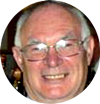
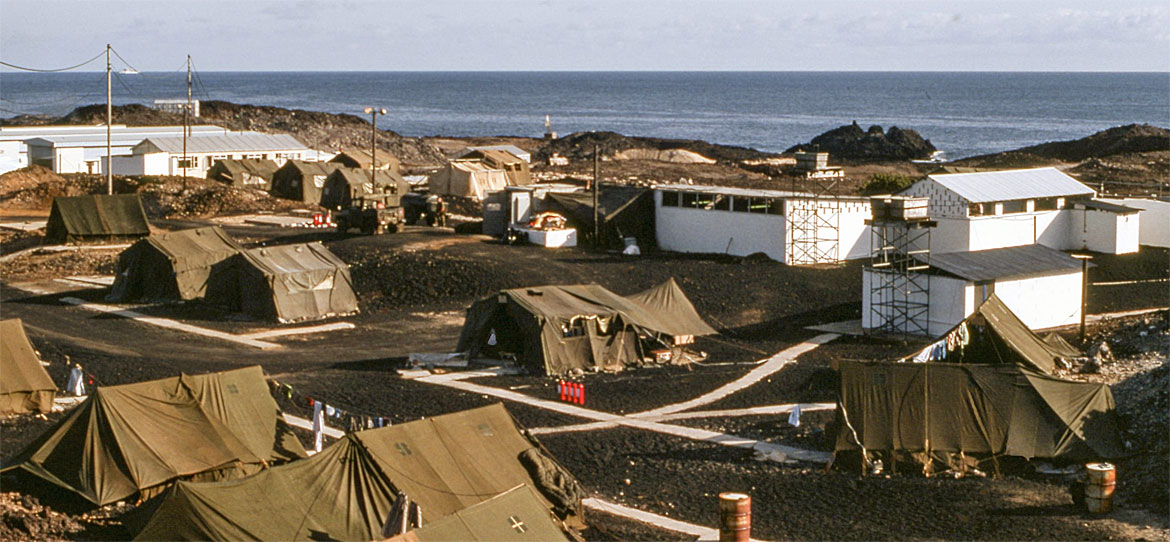
Our tent is centre rear with the white extension. Dave Giles' tent is in the foreground next to the concrete path. The ablution block is upper right
Catering was on hand provided by the RAF Mobile Catering Support Unit (MCSU) and throughout the food was superb. A few weeks into the Det the Army Catering Corps set up a Field Kitchen on the airfield itself. The food was so crap we preferred to drive the 16 mile round trip for a decent meal. Being just above the Equator the temp day and night was always hot. Within days of arrival I had requested from UK some white cotton sheets and these I slept in on top of my maggot for the duration.
For most of our stay the tented camp was run by the Navy and their SWO equivalent (FCPO) was affectionately known as 'Popeye'. More than once, after a hot gruelling night shift, we would arrive back at the camp around 07:30 and head for Dave Giles' tent where there was always a stock of cold drinks. We would sit outside the tent having a 'Sun-Upper' of a can of beer. However in front of the tent was usually the orderly queue for the MCSU breakfast. Popeye berated us by saying he knew we were off-shift but it looked to the others in the queue that the Movers were all boozers and could we drink inside the tent? On one occasion, inside their tent I went to sit on a towel covered box.... "Don't sit on the...!" someone said as the world exploded and I was washed out of the tent along with an avalanche of ice, Budweiser and Coke cans and icy water. I'd sat on and destroyed their 40 litre polystyrene cooler box. I did replace it.
Ian
For most of our stay the tented camp was run by the Navy and their SWO equivalent (FCPO) was affectionately known as 'Popeye'. More than once, after a hot gruelling night shift, we would arrive back at the camp around 07:30 and head for Dave Giles' tent where there was always a stock of cold drinks. We would sit outside the tent having a 'Sun-Upper' of a can of beer. However in front of the tent was usually the orderly queue for the MCSU breakfast. Popeye berated us by saying he knew we were off-shift but it looked to the others in the queue that the Movers were all boozers and could we drink inside the tent? On one occasion, inside their tent I went to sit on a towel covered box.... "Don't sit on the...!" someone said as the world exploded and I was washed out of the tent along with an avalanche of ice, Budweiser and Coke cans and icy water. I'd sat on and destroyed their 40 litre polystyrene cooler box. I did replace it.
Ian

From: Alex Masson, Tunbridge Wells, Kent
Subject: Under Canvas
Dear Tony,
You will be aware of my time on Christmas Island (Kiritimati), in the Gilbert and Ellice Islands in the Pacific Ocean, working support for Operation Grapple, the Hydrogen Bomb Tests.
I arrived on the Island on the 8th of December 1956, and left on the 10th of September 1957. Roughly ten months on the Island. During my time there, I had been down to Australia and back, taking in Amberley and Edinburgh Field, where we were at the Rocket Range. I was there just over a week, but we were living in hotels. But for the rest of my time I was on the island under canvas! There were 6,000 of us living on the Island.
Alex Masson,
Corporal Air Movements.
Subject: Under Canvas
Dear Tony,
You will be aware of my time on Christmas Island (Kiritimati), in the Gilbert and Ellice Islands in the Pacific Ocean, working support for Operation Grapple, the Hydrogen Bomb Tests.
I arrived on the Island on the 8th of December 1956, and left on the 10th of September 1957. Roughly ten months on the Island. During my time there, I had been down to Australia and back, taking in Amberley and Edinburgh Field, where we were at the Rocket Range. I was there just over a week, but we were living in hotels. But for the rest of my time I was on the island under canvas! There were 6,000 of us living on the Island.
Alex Masson,
Corporal Air Movements.

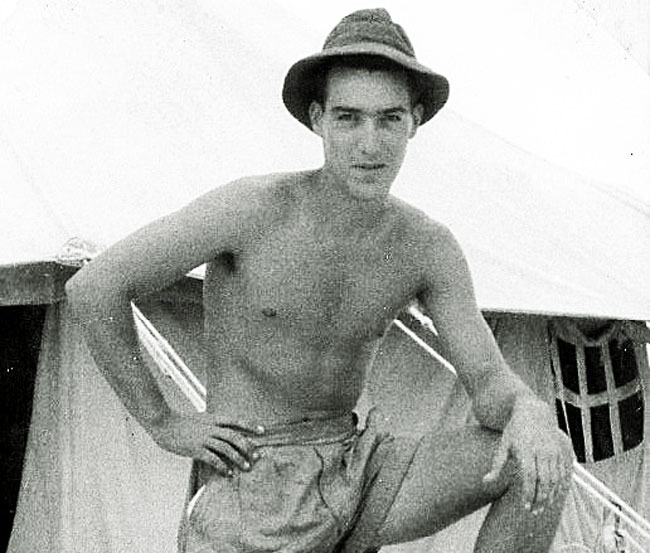
Britain's H-Bomb Test - 1957
From: Mark Attrill, Tartu
Subject: Under Canvas
Tony,
I think I was one of those that drew the 'short straw' during my early years in the RAF, since I managed to end up doing quite a few 'tent jobs' as one of the other team leaders euphemistically called 'living under canvas', when I was on UKMAMS. In my case it was most notably during my time as OC MSF at Coltishall and at RDAF Tirstrup but I do also recall one amusing incident at Lyneham during my time on the Squadron. We were all heading into a major TACEVAL and the relatively new OC (Bob Dixon) and even newer OC MAMF (Pete Arnold) decided that we should have a dry run.
My team and that belonging to Mark Vincenti (Mark V) were tasked to load up our trusty team Landrover/trailer combos and deploy to the Southern side of RAF Brize Norton, which in those days was relatively under-populated (The VC10 tanker squadrons had not yet relocated). Once there, we were to establish a well-camouflaged, tactical airhead (i.e. erect our 'command' and accommodation tents), establish communications (by running to the nearest building and 'phone home') and sort out rationing etc. We were under strict instructions to maintain field conditions for however long we were going to be 'in the field' and to be prepared to be there for at least 48 hours.
Subject: Under Canvas
Tony,
I think I was one of those that drew the 'short straw' during my early years in the RAF, since I managed to end up doing quite a few 'tent jobs' as one of the other team leaders euphemistically called 'living under canvas', when I was on UKMAMS. In my case it was most notably during my time as OC MSF at Coltishall and at RDAF Tirstrup but I do also recall one amusing incident at Lyneham during my time on the Squadron. We were all heading into a major TACEVAL and the relatively new OC (Bob Dixon) and even newer OC MAMF (Pete Arnold) decided that we should have a dry run.
My team and that belonging to Mark Vincenti (Mark V) were tasked to load up our trusty team Landrover/trailer combos and deploy to the Southern side of RAF Brize Norton, which in those days was relatively under-populated (The VC10 tanker squadrons had not yet relocated). Once there, we were to establish a well-camouflaged, tactical airhead (i.e. erect our 'command' and accommodation tents), establish communications (by running to the nearest building and 'phone home') and sort out rationing etc. We were under strict instructions to maintain field conditions for however long we were going to be 'in the field' and to be prepared to be there for at least 48 hours.

The afternoon and evening wore on with no perceptible activity or tasking and the boys were getting restless. Working on the premise that we had become a 'fire and forget' asset back at RAF Lyneham, Mark V, as the senior team leader, decided that we should go to a local chippie in Carterton rather than endure another meal from the ration pack. I declined the offer on behalf of my team, much to their chagrin, since I had a 'sixth sense' about our newly-promoted boss and his boyish enthusiasm for his new assignment. Mark remained unconvinced and off he went with his team.
At around 8 o'clock, by which time it was very dark and we had adopted blackout procedures, there was still no sign of Mark V and his team when we heard a vehicle approaching and out stepped Sqn Ldr Arnold to see how his 'deployed team' were faring in the field!
Initially, he said nothing about the absence of the other team and focused on checking on how we had set ourselves up, what we had done etc. After a while, Mark V and his team rolled back into the site, having 'conducted a roving patrol around the southern side of RAF Brize Norton 'inside the wire'. All very good.
At around 8 o'clock, by which time it was very dark and we had adopted blackout procedures, there was still no sign of Mark V and his team when we heard a vehicle approaching and out stepped Sqn Ldr Arnold to see how his 'deployed team' were faring in the field!
Initially, he said nothing about the absence of the other team and focused on checking on how we had set ourselves up, what we had done etc. After a while, Mark V and his team rolled back into the site, having 'conducted a roving patrol around the southern side of RAF Brize Norton 'inside the wire'. All very good.

The following day, we received a message to return to base after which Mark V was summoned to the OC's office. The problem was that one of the Training Office bods had been tasked to stake out said chippie in Carterton the previous evening to check if we, or members of two other teams that had been tasked to camp out on the NE side of BZN had, in fact, availed ourselves of 'alternative rations' during the exercise. Needless to say, Paddy, Gonzo and the boys were grateful for the fact that my 'radar' had been working well on that particular 'tent job'.
Cheers,
Mark
Cheers,
Mark
'Tis true - when a mover retires, ACHE is replaced by ache!
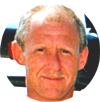
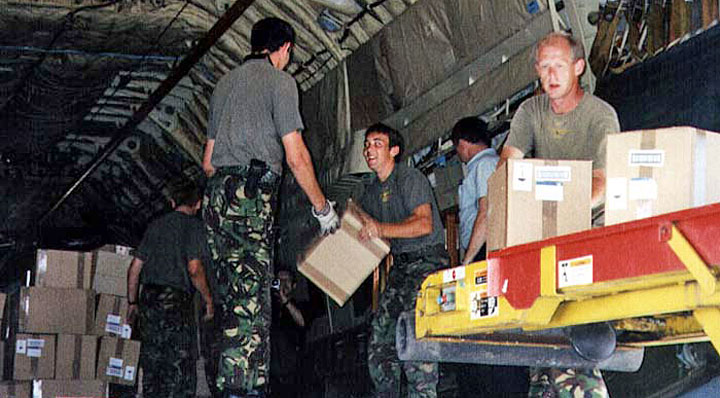
From: Michael Cocker, Swindon, Wilts
Subject: Under Canvas
Hi Tony,
"Under Canvas" is another interesting subject, and one to instill fear into most RAF personnel. A few exceptions like UKMAMS, TCW and TSW, but in the main the RAF usually managed a hard roof with a bar and restaurant. During my first tour on MAMS in the 80's, the vast majority of my tasks were in hotels at exotic locations - Hong Kong, Florida, Canada and New Zealand to name but a few. There were, however, a few exceptions, generally the Cold War exercises like the IALCE's in Denmark, which, while under canvas, were quite sophisticated, with decent heaters, cracking food from MCSU and we often availed ourselves of the RDAF bar facilities.
Things took a pretty drastic turn in the 90's though, and while I missed much of the early 90's Baltic campaigns, my camping began in earnest during Operation Agricola in Skopje, for the push into Pristina and Kosovo during May 1999. This was a particularly "bare" task, with the only washing facilities being either a bowl, or a borrow of the French shower trailer... we worked around 14 hours a day, drank a lot of beer afterwards, then tried to sleep in leaky tents next to the threshold while the USAF unloaded C-17's all night - a great detachment, just for the guys on it - if Carlsburg did composite MAMS teams, this was it.
Subject: Under Canvas
Hi Tony,
"Under Canvas" is another interesting subject, and one to instill fear into most RAF personnel. A few exceptions like UKMAMS, TCW and TSW, but in the main the RAF usually managed a hard roof with a bar and restaurant. During my first tour on MAMS in the 80's, the vast majority of my tasks were in hotels at exotic locations - Hong Kong, Florida, Canada and New Zealand to name but a few. There were, however, a few exceptions, generally the Cold War exercises like the IALCE's in Denmark, which, while under canvas, were quite sophisticated, with decent heaters, cracking food from MCSU and we often availed ourselves of the RDAF bar facilities.
Things took a pretty drastic turn in the 90's though, and while I missed much of the early 90's Baltic campaigns, my camping began in earnest during Operation Agricola in Skopje, for the push into Pristina and Kosovo during May 1999. This was a particularly "bare" task, with the only washing facilities being either a bowl, or a borrow of the French shower trailer... we worked around 14 hours a day, drank a lot of beer afterwards, then tried to sleep in leaky tents next to the threshold while the USAF unloaded C-17's all night - a great detachment, just for the guys on it - if Carlsburg did composite MAMS teams, this was it.
I spent 13 months on another instructing tour from June 2000 to July 2001, when I arrived back at RAF Lyneham, direct onto Mobile, and just in time for 9/11 and the operations that followed.
Exercise Saif Sarea II turned into Operations Fingal and Veritas, and the push into Afghanistan. We were in a large tented encampment in RAFO Thumrait, where I operated the TALCE with Viv Neary Philips, in contact with the guys on the ground in Afghanistan, and allocating the freight on the 6 Hercs doing their 24-hour round trip to Bagram, then Kabul.
Despite the HQ in Muscat believing they were in control, myself and Viv paid lip service to their instructions, while dealing direct with MCC Kabul and fulfilling their requirements - the HQ plan had failed the test on day 2 so needed to be bypassed!
I had a few days respite in the UK at some point here, but ended up in Salalah for a while, out-loading kit on AN-124's, but living at the port with 17 Port and Maritime Regiment - in portacabins, so almost camping.
Exercise Saif Sarea II turned into Operations Fingal and Veritas, and the push into Afghanistan. We were in a large tented encampment in RAFO Thumrait, where I operated the TALCE with Viv Neary Philips, in contact with the guys on the ground in Afghanistan, and allocating the freight on the 6 Hercs doing their 24-hour round trip to Bagram, then Kabul.
Despite the HQ in Muscat believing they were in control, myself and Viv paid lip service to their instructions, while dealing direct with MCC Kabul and fulfilling their requirements - the HQ plan had failed the test on day 2 so needed to be bypassed!
I had a few days respite in the UK at some point here, but ended up in Salalah for a while, out-loading kit on AN-124's, but living at the port with 17 Port and Maritime Regiment - in portacabins, so almost camping.
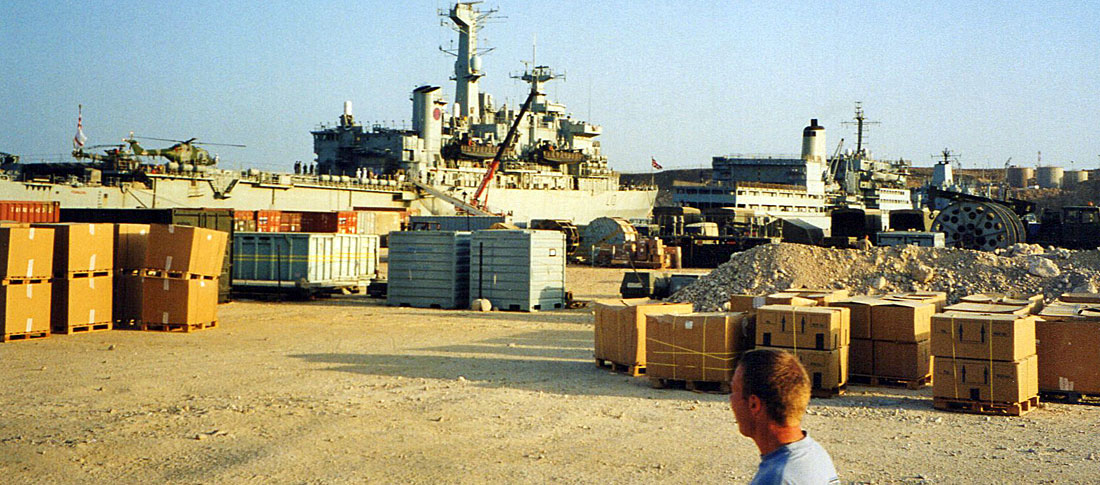
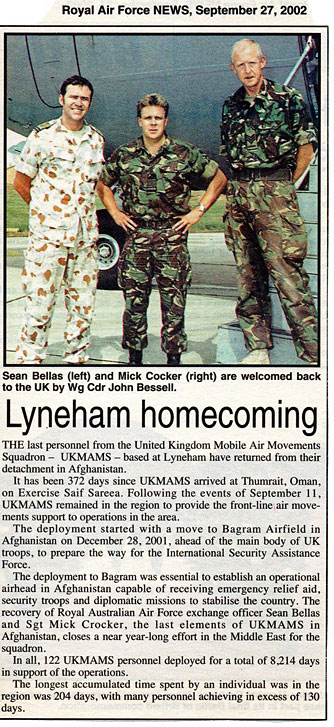
The last personnel from the United Kingdom Mobile Air Movements Squadron - UKMAMS - based at Lyneham have returned from their detachment in Afghanistan.
It has been 372 days since UKMAMS arrived at Thumrait, Oman, on Exercise Saif Sareea. Following the events of September 11, UKMAMS remained in the region to provide the front-line air movements support to operations in the area.
The deployment started with a move to Bagram Airfield in Afghanistan on December 28, 2001, ahead of the main body of UK troops, to prepare the way for the International Security Force.
The deployment to Bagram was essential to establish an operational airhead in Afghanistan capable of receiving emergency relief aid, security troops and diplomatic missions to stabilise the country. The recovery of Royal Australian Air Force exchange officer Sean Bellas and Sgt Mick Cocker, the last elements of UKMAMS in Afghanistan, closes a near year-long effort in the Middle East for the squadron.
In all, 122 UKMAMS personnel deployed for a total of 8,214 days in support of the operations.The longest accumulated time spent by an individual in the region was 204 days, with many personnel achieving in excess of 130 days.
It has been 372 days since UKMAMS arrived at Thumrait, Oman, on Exercise Saif Sareea. Following the events of September 11, UKMAMS remained in the region to provide the front-line air movements support to operations in the area.
The deployment started with a move to Bagram Airfield in Afghanistan on December 28, 2001, ahead of the main body of UK troops, to prepare the way for the International Security Force.
The deployment to Bagram was essential to establish an operational airhead in Afghanistan capable of receiving emergency relief aid, security troops and diplomatic missions to stabilise the country. The recovery of Royal Australian Air Force exchange officer Sean Bellas and Sgt Mick Cocker, the last elements of UKMAMS in Afghanistan, closes a near year-long effort in the Middle East for the squadron.
In all, 122 UKMAMS personnel deployed for a total of 8,214 days in support of the operations.The longest accumulated time spent by an individual in the region was 204 days, with many personnel achieving in excess of 130 days.
Sean Bellas (left) and Mick Cocker (right) are
welcomed back to the UK by Wg Cdr John Bessell
welcomed back to the UK by Wg Cdr John Bessell
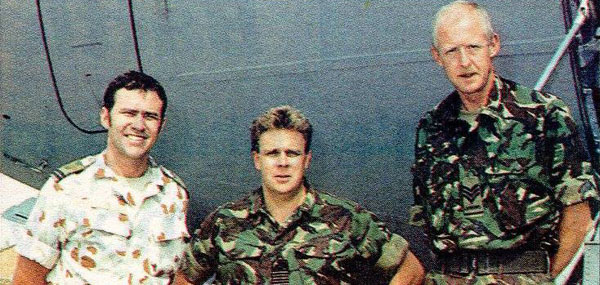
Lyneham Homecoming
By April 2002 I was on my first tour in Kabul, as the in-theatre C-17 Supervisor and Cargo SNCO, a busy time with more tents - at least this time with half decent washing and showering facilities - although little time to use them as my work day started at around 09:00 and finished after seeing the C-17 out around 04:30 the next morning - an exceptionally hard detachment, short of sleep and food, but I would not have missed it for the world.
After a few brief months on routine tasking, I found myself back in Afghanistan, this time Bagram, recovering the Chinooks to RAF Odiham. While not under canvas, it was in a bombed-out ex Soviet hangar, which we found out after the event, was full of asbestos! Recovery from there was around August 02.
After a few brief months on routine tasking, I found myself back in Afghanistan, this time Bagram, recovering the Chinooks to RAF Odiham. While not under canvas, it was in a bombed-out ex Soviet hangar, which we found out after the event, was full of asbestos! Recovery from there was around August 02.
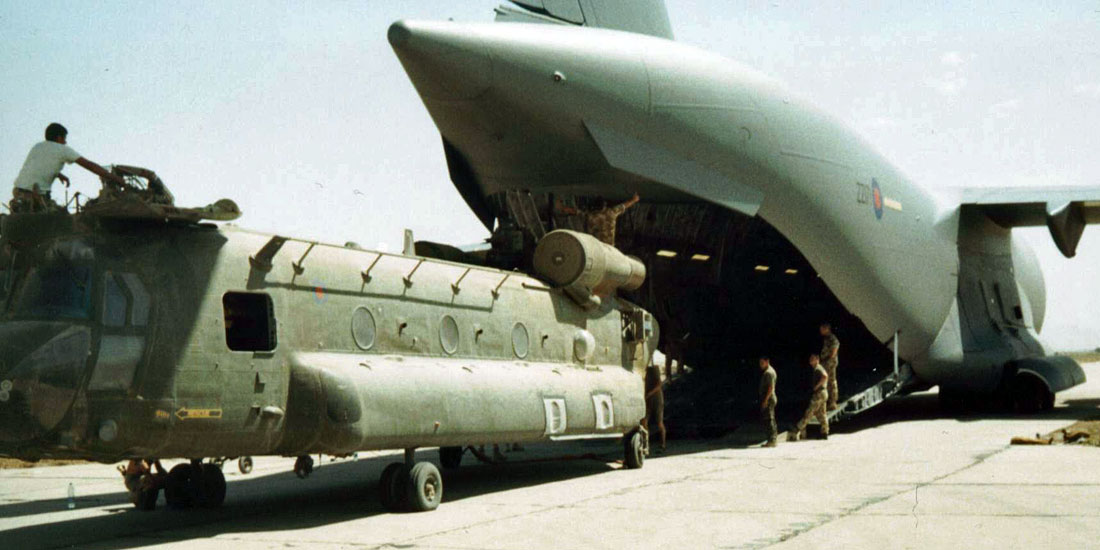
After a very short Winter of relatively normal tasking, along came Operation Telic - an initial deployment to Muscat lasted all of 2 hours and we were redeployed to Kuwait International Airport. A few days kicking my heels around here and I was selected from a cast of one to deploy with a team to assist the USAF with the USMC deployment at Al Jaber AB, Kuwait.
Myself, Tony Randerson, Paul Crake, Jon French and Amanda Baker set off in our Landrover and trailer, with tents, tables, genny's and beds and set up home on base. Despite being in a tent, we had dual voltage power, cable TV, fridge, and attached conference room - we even entertained the CAS, ACM Sir Peter Squire, who was quite reluctant to leave, and pointed out to his ADC that "the Aircraft leaves when I say it leaves"... Fortunately he declined Tony Randerson's offer of a glass of "Special" orange juice... that may have gone either way for Tony's career.
Myself, Tony Randerson, Paul Crake, Jon French and Amanda Baker set off in our Landrover and trailer, with tents, tables, genny's and beds and set up home on base. Despite being in a tent, we had dual voltage power, cable TV, fridge, and attached conference room - we even entertained the CAS, ACM Sir Peter Squire, who was quite reluctant to leave, and pointed out to his ADC that "the Aircraft leaves when I say it leaves"... Fortunately he declined Tony Randerson's offer of a glass of "Special" orange juice... that may have gone either way for Tony's career.


Sometime in April I spent 2 days in the UK, then went out to Akrotiri to do the bomb outloads to Azraq in Jordan for the Harrier detachment - I lived on board the C-17 for days on end for this task, but was exceptionally well looked after by the crews, and probably had better sleep than being in a tent. This was, however, a sign of things to come, as I deployed to Azraq in June 03 to recover the Harriers - once again under canvas.
I can honestly say, after 30 years in the RAF, this was by far the biggest bunch of arrogant tarts I have ever come across... how on earth they ever got their job done God only knows. If ever there was a prize for knowing everyone else's job, while knowing bugger all about it, it would go to 1 Squadron Harriers. Their inability to comprehend their position in life was mind boggling - OC 1 Sqn actually booked a Sky TV crew to meet them at RAF Wittering, without even having the airlift to take them home - and suddenly it became my problem!
Whilst pondering life in my tent overnight, and possibly sharing a beer with Geordie Henderson, Dave Brown and Matt Hadfield, I called a pal, and got a Tristar KC1 to take the buffoons home... I was pleased to be rid of the fools, but it wasn't without incident. After loading the aircraft, OC 1 Sqn gathered everyone together and offered them the chance to stay in Azraq to complete their 90 days - I then pointed out it would be without clothing as we would not be unloading the Tristar to find baggage - 3 people still elected to stay behind. They asked me if I could send them home 3 days later - it took 2 weeks!
This Detachment was by no means the end of my camping shenanigans with the RAF, but by 2008 I had become a little bit too tired to continue so decided to leave. I will add, that in all the time we had our backs to the wall, and often overworked and very hungry, many of the C-130 and C-17 crews supported us with pizza's and Subways from Bahrain... at no cost - and I was fortunate enough to be able to reciprocate while I was RAFLO Incirlik (C-17 Sup). Those crews did us proud and it was great to work with them.
I can honestly say, after 30 years in the RAF, this was by far the biggest bunch of arrogant tarts I have ever come across... how on earth they ever got their job done God only knows. If ever there was a prize for knowing everyone else's job, while knowing bugger all about it, it would go to 1 Squadron Harriers. Their inability to comprehend their position in life was mind boggling - OC 1 Sqn actually booked a Sky TV crew to meet them at RAF Wittering, without even having the airlift to take them home - and suddenly it became my problem!
Whilst pondering life in my tent overnight, and possibly sharing a beer with Geordie Henderson, Dave Brown and Matt Hadfield, I called a pal, and got a Tristar KC1 to take the buffoons home... I was pleased to be rid of the fools, but it wasn't without incident. After loading the aircraft, OC 1 Sqn gathered everyone together and offered them the chance to stay in Azraq to complete their 90 days - I then pointed out it would be without clothing as we would not be unloading the Tristar to find baggage - 3 people still elected to stay behind. They asked me if I could send them home 3 days later - it took 2 weeks!
This Detachment was by no means the end of my camping shenanigans with the RAF, but by 2008 I had become a little bit too tired to continue so decided to leave. I will add, that in all the time we had our backs to the wall, and often overworked and very hungry, many of the C-130 and C-17 crews supported us with pizza's and Subways from Bahrain... at no cost - and I was fortunate enough to be able to reciprocate while I was RAFLO Incirlik (C-17 Sup). Those crews did us proud and it was great to work with them.
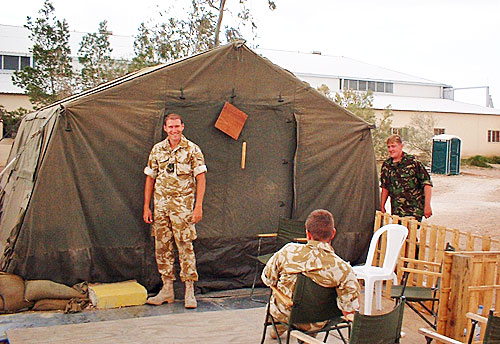
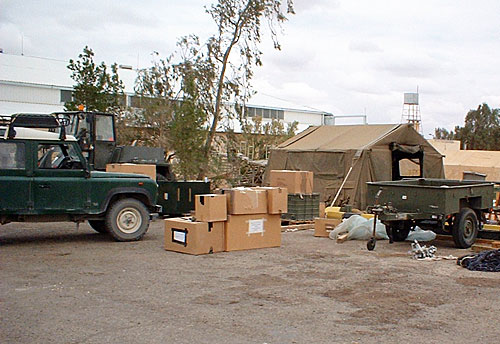

As an addition, and to put things into perspective, I have enclosed a picture of my grandfather - Sgt Stanley Cocker MM, 5th Batt Seaforth Highlanders.
He spent 3 years under canvas from May 1915 - Dec 1918. He was on the southern sector of the Somme on 1 Jul 1916, so fortunately missed the main assault - but subsequently was at Beaumont Hamel, Second Ypres and third Ypres (Passchendaele) fronts.
He was hospitalised for 3 years from Dec 1918 - Diagnosed "Sickness Mild". He survived till he was 80, but WW1 followed him forever.
Shell Shock and early onset Parkinson's (age 33) stifled his life a bit, but he attended all his Regimental reunions in Edinburgh and lived his life, as far as possible, to the full.
My best to all
Mick
He spent 3 years under canvas from May 1915 - Dec 1918. He was on the southern sector of the Somme on 1 Jul 1916, so fortunately missed the main assault - but subsequently was at Beaumont Hamel, Second Ypres and third Ypres (Passchendaele) fronts.
He was hospitalised for 3 years from Dec 1918 - Diagnosed "Sickness Mild". He survived till he was 80, but WW1 followed him forever.
Shell Shock and early onset Parkinson's (age 33) stifled his life a bit, but he attended all his Regimental reunions in Edinburgh and lived his life, as far as possible, to the full.
My best to all
Mick
Sgt Stanley Cocker MM

Actor Clive Standen Joins the RAF for an Exclusive Week with 1 Air Mobility Wing at Brize Norton
Actor Clive Standen, best known for his roles in Vikings and Taken, steps out of the studio and into the world of military operations. This time, there’s no script, just hands-on experience as Standen joins 1 Air Mobility Wing at RAF Brize Norton, the UK’s largest military air base.
For one week, Standen immerses himself in the fast-paced world of air mobility, logistics, and precision military operations, experiencing the discipline and teamwork that make the RAF a vital component of UK defence.
The video takes viewers behind the scenes, showcasing everything from early mornings to high-stakes air missions. Standen is pushed to his limits in a series of challenging, real-world scenarios alongside the personnel who serve within the RAF.
This unique, behind-the-scenes footage offers insight into the demanding life of military personnel, far from the glamour of Hollywood. It’s a must-watch for anyone curious about what powers the Royal Air Force’s operations in the UK and across the globe.
raf.mod.uk
For one week, Standen immerses himself in the fast-paced world of air mobility, logistics, and precision military operations, experiencing the discipline and teamwork that make the RAF a vital component of UK defence.
The video takes viewers behind the scenes, showcasing everything from early mornings to high-stakes air missions. Standen is pushed to his limits in a series of challenging, real-world scenarios alongside the personnel who serve within the RAF.
This unique, behind-the-scenes footage offers insight into the demanding life of military personnel, far from the glamour of Hollywood. It’s a must-watch for anyone curious about what powers the Royal Air Force’s operations in the UK and across the globe.
raf.mod.uk

Watch on YouTube - https://www.youtube.com/watch?v=T2ixkEIYTog


From: Colin Eyre, Bridgend, Glamorgan
Subject: Under Canvas
Hi Tony,
I was never put through the ordeal of roughing it, but I did come close to it once. It was 1959 to 1961, 38th entry Credenhill, Hereford. It was decided by the powers that be that we should experience the outdoors and so we were taken over the border to the Black Mountains. For those who don’t know it, this is SAS training country in Wales, where we have quite a fair share of wet weather.
So, surprise-surprise, when we arrived at our camp site it was during a torrential downpour. So much for checking the weather forecast. It did not take long for the instructors to decide that the conditions were too rough for us young lads. So, it was back on to the 4-tonner and return to Credenhill. A narrow escape.
Rgds
Colin
Subject: Under Canvas
Hi Tony,
I was never put through the ordeal of roughing it, but I did come close to it once. It was 1959 to 1961, 38th entry Credenhill, Hereford. It was decided by the powers that be that we should experience the outdoors and so we were taken over the border to the Black Mountains. For those who don’t know it, this is SAS training country in Wales, where we have quite a fair share of wet weather.
So, surprise-surprise, when we arrived at our camp site it was during a torrential downpour. So much for checking the weather forecast. It did not take long for the instructors to decide that the conditions were too rough for us young lads. So, it was back on to the 4-tonner and return to Credenhill. A narrow escape.
Rgds
Colin
From: Colin Waitt, Herndon, VA
Subject: Under Canvas
Tony,
Two recollections concerning under canvas. Both very different which I think encapsulates life on UKMAMS. As you never could tell what tomorrow would bring.
The first was early 1984 as depicted in the “clipping” below. The USAF aerial port squadron had just been deployed to Granada and had had some issues so UKMAMS were called in to help them in learning about living under canvas. We were mainly Delta and Echo teams – I think. We pitched up in our land rovers and trailers and they turned up in a convoy complete with generator powered lights and heaters. It proved interesting thereafter.
Subject: Under Canvas
Tony,
Two recollections concerning under canvas. Both very different which I think encapsulates life on UKMAMS. As you never could tell what tomorrow would bring.
The first was early 1984 as depicted in the “clipping” below. The USAF aerial port squadron had just been deployed to Granada and had had some issues so UKMAMS were called in to help them in learning about living under canvas. We were mainly Delta and Echo teams – I think. We pitched up in our land rovers and trailers and they turned up in a convoy complete with generator powered lights and heaters. It proved interesting thereafter.

SAS training grounds - The Black Mountains, South Wales

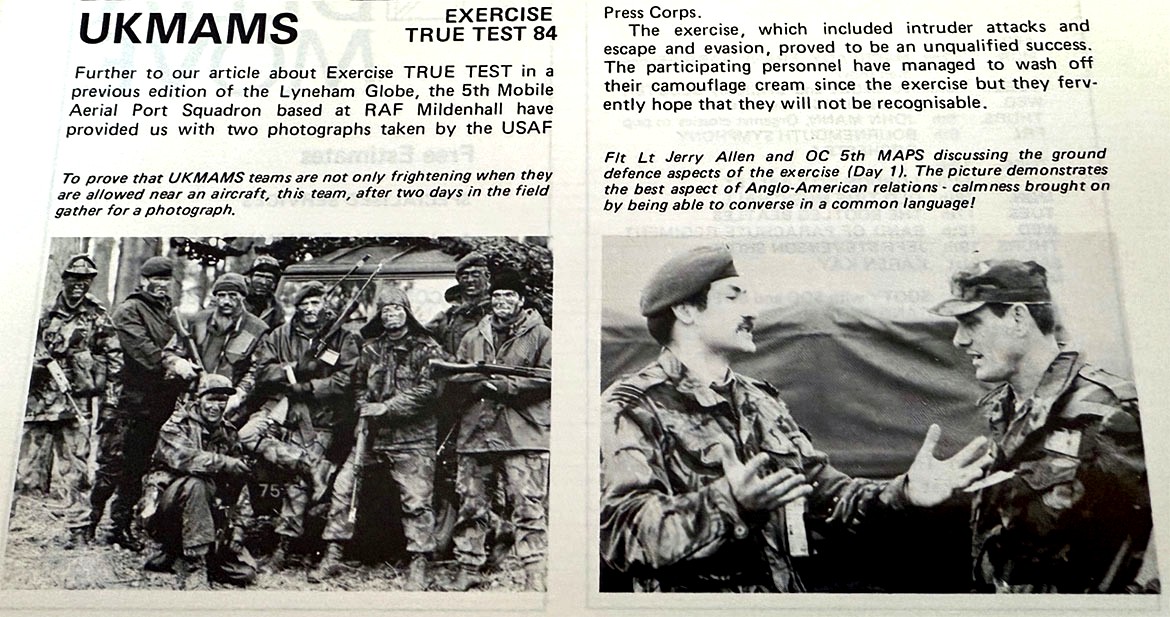
Second “under canvas” in 1984 was Operation Bushel when at very short notice - days – around 3 teams were deployed to Ethiopia. Our initial detachment was housed in the British Embassy grounds in tented accommodation to be known as “Muppetsville”. We stayed there for several weeks and went out on the daily food runs from Addis Ababa to the port of Assab and then to the camps at Mekele and Gondar to name a couple. An interesting time which I now realize was over 40 years ago. Picture below is myself and Steve Heaton. I think the picture was taken for some article at the time.
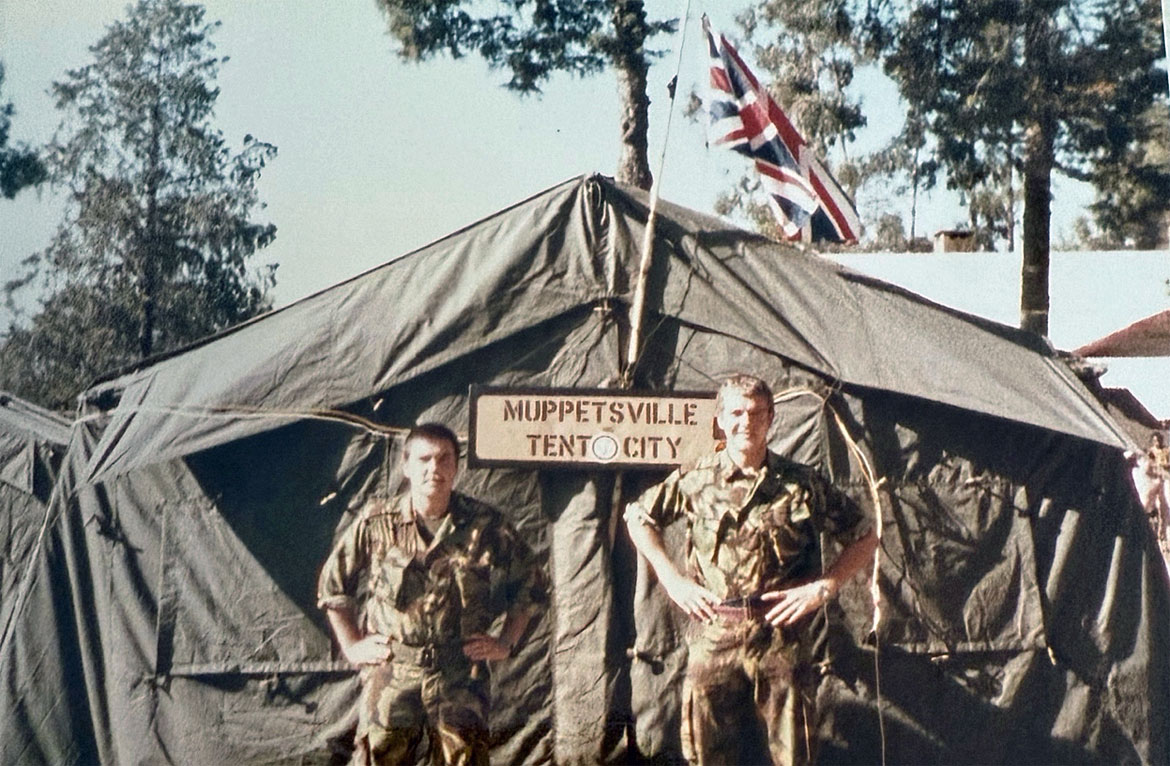
Best regards,
Colin
Colin
This Newsletter is Dedicated
to the Memories of:
Mike Rowan (RAF)
Pete Crotty (RNZAF)
to the Memories of:
Mike Rowan (RAF)
Pete Crotty (RNZAF)
Tony Gale
ukmamsoba@gmail.com
ukmamsoba@gmail.com
.
